Poetry in Pandemic: A Multimodal Neuroaesthetic Study on the Emotional Reaction to the Divina Commedia Poem
Abstract
1. Introduction
- To investigate the different emotional responses (assessed using biosignal-based and self-report subjective measures) according to the structure (cantica) and the different modalities of fruition (read/listened to) of Dante Alighieri’s Divina Commedia between literature-skilled and non-literature-skilled students and the possible association with the presence of alexithymia during COVID confinement.
- To investigate whether, while listening to Dante’s poem, the coded emotions and self-reported perception vary according to the poem’s structure, the qualitative characteristics of the acting voice and the listener’s characteristics.
2. Materials and Methods
2.1. Experimental Sample
2.2. Stimuli and Experimental Protocol
2.3. Measures
2.4. Statistical Analysis
3. Results
3.1. How Expertise and Alexithymia Impact Encoded Emotions and Self-Reported Perceptions in Relation to MOF (Listening/Reading) of the Divina Commedia
3.1.1. Impact on Emotions
3.1.2. Impact on Self-Reported Perception
3.2. How Encoded Emotions and Self-Reported Perception Vary between Groups According to the Structure (Cantica) and the MOF (Listening/Reading) of the Divine Comedy
3.2.1. Emotions Variations
3.2.2. Self-Reported Perception Variations
3.3. Behavioural Outcomes: Recall
3.4. How the Characteristics of the Reciting Voice Influence the Expression of Emotions and Self-Reported Subjective Perception between Groups
3.4.1. Influence on Emotions
3.4.2. Influence on Self-Reported Perception
4. Discussion
5. Conclusions and Limits
- The comparison between MOF and the structure of the Divina Commedia concerning the groups (LS-SS; AOT-NA) shows how the participants’ expertise influences the emotions of JOY and FEAR: LSs show more JOY and FEAR towards the poem. Whereas AOTs express more NEUTRALITY towards listening than NAs. In general, listening to MOF is considered more INTENSE, while PLEASANTNESS is not influenced by the mode but by the structure of the work. POSITIVITY is modulated by expertise, while arousal INTENSITY is by the alexithymic factor.
- Considering only auditory stimulation and voice characteristics, besides the greater JOY for listening and NEUTRALITY towards the male voice expressed by LSs, SURPRISE is modulated by alexithymia, whereas the structure of the poem modulates DISGUST and SADNESS. Subjectively, when listening, the female acting voice is perceived as more PLEASANT as well as being considered of greatest arousal INTENSITY.
Author Contributions
Funding
Institutional Review Board Statement
Informed Consent Statement
Data Availability Statement
Acknowledgments
Conflicts of Interest
Appendix A
| Inferno canto V Excerpts (vv. 127–138) | English Translation |
| Noi leggiavamo un giorno per diletto di Lanciallotto come amor lo strinse: soli eravamo e sanza alcun sospetto | One day we reading were for our delight Of Launcelot, how Love did him enthrall. Alone we were and without any fear. |
| Per più fiate li occhi ci sospinse quella lettura, e scolorocci il viso; ma solo un punto fu quel che ci vinse | Full many a time our eyes together drew That reading, and drove the color from our faces; But one point only was it that o’ercame us. |
| Quando leggemmo il disiato riso esser baciato da cotanto amante, questi, che mai da me non fia diviso | When as we read of the much longed-for smile Being by such a noble lover kissed, This one, who ne’er from me shall be divided |
| la bocca mi baciò tutto tremante. Galeotto fu il libro e chi lo scrisse: quel giorno più non vi leggemmo avante | Kissed me upon the mouth all palpitating. Galeotto was the book and he who wrote it. That day no farther did we read therein. |
| Purgatorio canto XXX excerpts (vv. 67–78) | English translation |
| Tutto che ‘l vel che le scendea di testa, cerchiato delle fronde di Minerva, non la lasciasse parer manifesta, | Although the veil, that from her head descended, Encircled with the foliage of Minerva, Did not permit her to appear distinctly, |
| regalmente nell’atto ancor proterva continuò come colui che dice e ‘l più caldo parlar dietro reserva: | In attitude still royally majestic Continued she, like unto one who speaks, And keeps his warmest utterance in reserve: |
| -Guardaci ben! Ben son, ben son Beatrice. Come degnasti d’accedere al monte? non sapei tu che qui è l’uom felice?- | “Look at me well; in sooth I’m Beatrice! How didst thou deign to come unto the Mountain? Didst thou not know that man is happy here?ˮ |
| Li occhi mi cadder giù nel chiaro fonte; ma veggendomi in esso, i trassi all’erba, tanta vergogna mi gravò la fronte. | Mine eyes fell downward into the clear fountain, But, seeing myself therein, I sought the grass, So great a shame did weigh my forehead down |
| Paradiso canto XXXIII excerpts (vv. 133–145) | English translation |
| Qual è ‘l geomètra che tutto s’affige per misurar lo cerchio, e non ritrova, pensando, quel principio ond’elli indige, | As the geometrician, who endeavours To square the circle, and discovers not, By taking thought, the principle he wants, |
| tal era io a quella vista nova: veder volea come si convenne l’imago al cerchio e come vi s’indova; | Even such was I at that new apparition; I wished to see how the image to the circle Conformed itself, and how it there finds place; |
| ma non eran da ciò le proprie penne: se non che la mia mente fu percossa da un fulgore in che sua voglia venne. | But my own wings were not enough for this, Had it not been that then my mind there smote A flash of lightning, wherein came its wish. |
| All’alta fantasia qui mancò possa; ma già volgeva il mio disio e ‘l velle, sì come rota ch’igualmente è mossa, | Here vigour failed the lofty fantasy: But now was turning my desire and will, Even as a wheel that equally is moved, |
| l’amor che move il sole e l’altre stelle. | The Love which moves the sun and the other stars. |
References
- Nadal, M.; Skov, M. Introduction to the special issue: Toward an interdisciplinary neuroaesthetics. Psychol. Aesthet. Creat. Arts 2013, 7, 1–12. [Google Scholar] [CrossRef]
- Lorblanchet, M. The Origin of Art. Diogenes 2007, 54, 98–109. [Google Scholar] [CrossRef]
- Di Stefano, N. Historical Origins and Conceptual Foundations of Neuroaesthetics. Available online: https://lexicon.mimesisjournals.com/archive/2020/autumn/Neuroaesthetics.pdf (accessed on 6 March 2023).
- Changeux, J.P.; Mandelbrojt, J.; Yves, B.; Lemeunier, Y. Art and neuroscience. Leonardo 1994, 27, 189–201. [Google Scholar] [CrossRef]
- Zeki, S. Art and the brain. J. Conscious. Stud. 1999, 6, 76–96. [Google Scholar]
- Zeki, S. Inner vision: An exploration of art and the brain. J. Aesthet. Art Crit. 2002, 60, 365–366. [Google Scholar]
- Nalbantian, S. Neuroaesthetics: Neuroscientific theory and illustration from the arts. Interdiscip. Sci. Rev. 2008, 33, 357–368. [Google Scholar] [CrossRef]
- Zeki, S.; Lamb, M. The neurology of kinetic art. Brain 1994, 117, 607–636. [Google Scholar] [CrossRef]
- Nadal, M.; Pearce, M.T. The Copenhagen Neuroaesthetics conference: Prospects and pitfalls for an emerging field. Brain Cogn. 2011, 76, 172–183. [Google Scholar] [CrossRef]
- Brattico, E. The neuroaesthetics of music: A research agenda coming of age. In the Oxford Handbook of Music and the Brain; Thaut, M.H., Hodges, D.A., Eds.; Oxford University Press: Oxford, UK, 2019. [Google Scholar]
- Darwin, C. The Expression of the Emotions in Man and Animals; John Murray: London, UK, 1872. [Google Scholar]
- Cabanac, M. What is emotion? Behav. Process. 2002, 60, 69–83. [Google Scholar] [CrossRef]
- Damasio, A.R. Emotion in the perspective of an integrated nervous system. Brain Res. Rev. 1998, 26, 83–86. [Google Scholar] [CrossRef]
- Boğa, M.; Koyuncu, M.; Kaça, G.; Bayazıt, T.O. Comparison of emotion elicitation methods: 3 methods, 3 emotions, 3 measures. Curr. Psychol. 2022, 2022, 1–16. [Google Scholar] [CrossRef]
- Panksepp, J. Affective Neuroscience: The Foundations of Human and Animal Emotions; Oxford university press: Oxford, UK, 1998. [Google Scholar]
- Ekman, P.; Friesen, W.V. Constants across cultures in the face and emotion. J. Personal. Soc. Psychol. 1971, 17, 124–129. [Google Scholar] [CrossRef]
- Fridlund, A.J.; Ekman, P.; Oster, H. Facial expressions of emotion. In Nonverbal Behavior and Communication, 2nd ed.; Siegman, A.W., Feldstein, S., Eds.; Lawrence Erlbaum Associates, Inc.: Hillsdale, NJ, USA, 1987; pp. 143–223. [Google Scholar]
- Izard, C.E. The Face of Emotion; Appleton-Century-Crofts: East Norwalk, CT, USA, 1971. [Google Scholar]
- Russell, J.A. A circumplex model of affect. J. Pers. Soc. Psychol. 1980, 39, 1161. [Google Scholar] [CrossRef]
- Kissler, J. Love Letters and Hate Mail: Cerebral Processing of Emotional Language Content; Cambridge University: Cambridge, UK, 2013. [Google Scholar]
- Pițur, S.; Miu, A.C. Poetry-elicited emotions: Reading experience and psychological mechanisms. Psychol. Aesthet. Creat. Arts 2022. [Google Scholar] [CrossRef]
- Johnson-Laird, P.N.; Oatley, K. Emotions, Music, and Literature. In Handbook of Emotions, 3rd ed.; Lewis, M., Haviland-Jones, J.M., Barrett, L.F., Eds.; Guilford Press: New York, NY, USA, 2008; pp. 102–113. [Google Scholar]
- Johnson-Laird, P.N.; Oatley, K. How poetry evokes emotions. Acta Psychol. 2022, 224, 103506. [Google Scholar] [CrossRef]
- Wassiliwizky, E.; Koelsch, S.; Wagner, V.; Jacobsen, T.; Menninghaus, W. The emotional power of poetry: Neural circuitry, psychophysiology and compositional principles. Soc. Cogn. Affect. Neurosci. 2017, 12, 1229–1240. [Google Scholar] [CrossRef]
- Lüdtke, J.; Meyer-Sickendieck, B.; Jacobs, A.M. Immersing in the stillness of an early morning: Testing the mood empathy hypothesis of poetry reception. Psychol. Aesthet. Creat. Arts 2014, 8, 363. [Google Scholar] [CrossRef]
- Menninghaus, W.; Blohm, S. Empirical aesthetics of poetry. In The Oxford Handbook of Empirical Aesthetics; Nadal, M., Vartanian, O., Eds.; Oxford University Press: Oxford, UK, 2020; pp. 1–20. [Google Scholar] [CrossRef]
- Obermeier, C.; Menninghaus, W.; von Koppenfels, M.; Raettig, T.; Schmidt-Kassow, M.; Otterbein, S.; Kotz, S.A. Aesthetic and emotional effects of meter and rhyme in poetry. Front. Psychol. 2013, 4, 10. [Google Scholar] [CrossRef] [PubMed]
- Menninghaus, W.; Wagner, V.; Wassiliwizky, E.; Jacobsen, T.; Knoop, C.A. The emotional and aesthetic powers of parallelistic diction. Poetics 2017, 63, 47–59. [Google Scholar] [CrossRef]
- Cartocci, G.; Rossi, D.; Modica, E.; Maglione, A.G.; Martinez Levy, A.C.; Cherubino, P.; Babiloni, F. NeuroDante: Poetry mentally engages more experts but moves more non-experts, and for both the cerebral approach tendency goes hand in hand with the cerebral effort. Brain Sci. 2021, 11, 281. [Google Scholar] [CrossRef] [PubMed]
- Antonelli, R. Memoria rerum et memoria verborum. La costruzione della Divina Commedia. Criticón 2003, 87, 88–89. [Google Scholar]
- Stockwell, P. Cognitive Poetics: An Introduction; Routledge: London, UK, 2019. [Google Scholar]
- Finnegan, R. Oral Poetry: Its Nature, Significance and Social Context; Wipf and Stock Publishers: Eugene, OR, USA, 2018. [Google Scholar]
- Zumthor, P. Introduction à la poésie orale; U of Minnesota Press: Minneapolis, MN, USA, 1990; Volume 70. [Google Scholar]
- Danesi, M. Vico, Metaphor, and the Origin of Language; Indiana University Press: Bloomington, IN, USA, 1993. [Google Scholar]
- Bloomfield, M.W. Poetry in early societies. Proc. Am. Philos. Soc. 1986, 130, 247–250. [Google Scholar]
- Wagner, V.; Scharinger, M.; Knoop, C.A.; Menninghaus, W. Effects of continuous self-reporting on aesthetic evaluation and emotional responses. Poetics 2021, 85, 101497. [Google Scholar] [CrossRef]
- Nenadić, F.; Vejnović, D.; Marković, S. Subjective experience of poetry: Latent structure and differences between experts and non-experts. Poetics 2019, 73, 100–113. [Google Scholar] [CrossRef]
- Sifneos, P.E. The prevalence of ‘alexithymic’characteristics in psychosomatic patients. Psychother. Psychosom. 1973, 22, 255–262. [Google Scholar] [CrossRef] [PubMed]
- Taylor, G.J. The alexithymia construct: Conceptualization, validation, and relationship with basic dimensions of personality. New Trends Exp. Clin. Psychiatry 1994, 10, 61–74. [Google Scholar]
- Wagner, H.; Lee, V. Alexithymia and individual differences in emotional expression. J. Res. Personal. 2008, 42, 83–95. [Google Scholar] [CrossRef]
- Jack, R.E.; Schyns, P.G. The human face as a dynamic tool for social communication. Curr. Biol. 2015, 25, R621–R634. [Google Scholar] [CrossRef]
- Grynberg, D.; Chang, B.; Corneille, O.; Maurage, P.; Vermeulen, N.; Berthoz, S.; Luminet, O. Alexithymia and the processing of emotional facial expressions (EFEs): Systematic review, unanswered questions and further perspectives. PLoS ONE 2012, 7, e42429. [Google Scholar] [CrossRef]
- Zhang, L.; Xuan, R.; Chen, Q.; Zhao, Q.; Shi, Z.; Du, J.; Wang, K. High-definition transcranial direct current stimulation modulates eye gaze on emotional faces in college students with alexithymia: An eye-tracking study. Prog. Neuro-Psychopharmacol. Biol. Psychiatry 2022, 116, 110521. [Google Scholar] [CrossRef]
- Goerlich-Dobre, K.S.; Witteman, J.; Schiller, N.O.; van Heuven, V.J.; Aleman, A.; Martens, S. Blunted feelings: Alexithymia is associated with a diminished neural response to speech prosody. Soc. Cogn. Affect. Neurosci. 2014, 9, 1108–1117. [Google Scholar] [CrossRef] [PubMed]
- Guazzini, A.; Pesce, A.; Marotta, L.; Duradoni, M. Through the Second Wave: Analysis of the Psychological and Perceptive Changes in the Italian Population during the COVID-19 Pandemic. Int. J. Environ. Res. Public Health 2022, 19, 1635. [Google Scholar] [CrossRef] [PubMed]
- Inguscio BM, S.; Nicastri, M.; Giallini, I.; Greco, A.; Babiloni, F.; Cartocci, G.; Mancini, P. School wellbeing and psychological characteristics of online learning in families of children with and without hearing loss during the COVID-19 pandemic. Psychol. Sch. 2023, 60, 78–104. [Google Scholar] [CrossRef] [PubMed]
- Fioravanti, G.; Benucci, S.B.; Prostamo, A.; Banchi, V.; Casale, S. Effects of the COVID-19 pandemic on psychological health in a sample of Italian adults: A three-wave longitudinal study. Psychiatry Res. 2022, 315, 114705. [Google Scholar] [CrossRef]
- Osimo, S.A.; Aiello, M.; Gentili, C.; Ionta, S.; Cecchetto, C. The influence of personality, resilience, and alexithymia on mental health during COVID-19 pandemic. Front. Psychol. 2021, 12, 630751. [Google Scholar] [CrossRef]
- Lim, J.Z.; Mountstephens, J.; Teo, J. Emotion recognition using eye-tracking: Taxonomy, review and current challenges. Sensors 2020, 20, 2384. [Google Scholar] [CrossRef]
- Chakraborty, S.; Aich, S.; Joo, M.I.; Sain, M.; Kim, H.C. A Multichannel Convolutional Neural Network Architecture for the Detection of the State of Mind Using Physiological Signals from Wearable Devices. J. Healthc. Eng. 2019, 2019, 5397814. [Google Scholar] [CrossRef]
- Babiloni, F.; Cherubino, P.; Graziani, I.; Trettel, A.; Bagordo, G.; Cundari, C.; Vecchiato, G. The great beauty: A neuroaesthetic study by neuroelectric imaging during the observation of the real Michelangelo’s Moses sculpture. In Proceedings of the 2014 36th Annual International Conference of the IEEE Engineering in Medicine and Biology Society, Chicago, IL, USA, 26–30 August 2014; pp. 6965–6968. [Google Scholar]
- Valenza, G.; Citi, L.; Lanatá, A.; Scilingo, E.P.; Barbieri, R. Revealing real-time emotional responses: A personalized assessment based on heartbeat dynamics. Sci. Rep. 2014, 4, 4998. [Google Scholar] [CrossRef] [PubMed]
- Gerger, G.; Leder, H.; Kremer, A. Context effects on emotional and aesthetic evaluations of artworks and IAPS pictures. Acta Psychol. 2014, 151, 174–183. [Google Scholar] [CrossRef]
- Rafique, S.; Kanwal, N.; Karamat, I.; Asghar, M.N.; Fleury, M. Towards estimation of emotions from eye pupillometry with low-cost devices. IEEE Access 2020, 9, 5354–5370. [Google Scholar] [CrossRef]
- Shu, L.; Xie, J.; Yang, M.; Li, Z.; Li, Z.; Liao, D.; Yang, X. A review of emotion recognition using physiological signals. Sensors 2018, 18, 2074. [Google Scholar] [CrossRef]
- Kim, J.; Kim, N. Quantifying Emotions in Architectural Environments Using Biometrics. Appl. Sci. 2022, 12, 9998. [Google Scholar] [CrossRef]
- Ekman, P. Lie catching and microexpressions. In The Philosophy of Deception; Oxford Univ. Press: London, UK, 2009; pp. 118–133. [Google Scholar]
- Ekman, P.; Friesen, W.V. Nonverbal leakage and clues to deception. Psychiatry 1969, 32, 88–106. [Google Scholar] [CrossRef] [PubMed]
- Ekman, P. Darwin, deception, and facial expression. Ann. N. Y. Acad. Sci. 2003, 1000, 205–221. [Google Scholar] [CrossRef] [PubMed]
- Goh, K.M.; Ng, C.H.; Lim, L.L.; Sheikh, U.U. Micro-expression recognition: An updated review of current trends, challenges and solutions. Vis. Comput. 2020, 36, 445–468. [Google Scholar] [CrossRef]
- Ekman, P.; Friesen, W.V. Facial Action Coding System; Consulting Psychologist: Palo Alto, CA, USA, 1978. [Google Scholar]
- Friesen, W.V.; Ekman, P. EMFACS-7: Emotional Facial Action Coding System; University of California at San Francisco: San Francisco, CA, USA, 1983; Volume 2, p. 1, Unpublished manuscript. [Google Scholar]
- Cohn, J.F.; Ambadar, Z.; Ekman, P. Observer-based measurement of facial expression with the Facial Action Coding System. Handb. Emot. Elicitation Assess. 2007, 1000, 205–221. [Google Scholar]
- Kayser, D.; Egermann, H.; Barraclough, N.E. Audience facial expressions detected by automated face analysis software reflect emotions in music. Behav. Res. Methods 2022, 54, 1493–1507. [Google Scholar] [CrossRef]
- Marin, M.M. Crossing boundaries: Toward a general model of neuroaesthetics. Front. Hum. Neurosci. 2015, 9, 443. [Google Scholar] [CrossRef]
- Lin, C.; Yeh, M.; Shams, L. Subliminal audio-visual temporal congruency in music videos enhances perceptual pleasure. Neurosci. Lett. 2022, 779, 136623. [Google Scholar] [CrossRef]
- Klasen, M.; Kreifelts, B.; Chen, Y.H.; Seubert, J.; Mathiak, K. Neural processing of emotion in multimodal settings. Front. Hum. Neurosci. 2014, 8, 1–4. [Google Scholar] [CrossRef]
- Mariooryad, S.; Busso, C. Exploring cross-modality affective reactions for audiovisual emotion recognition. IEEE Trans. Affect. Comput. 2013, 4, 183–196. [Google Scholar] [CrossRef]
- Faul, F.; Erdfelder, E.; Lang, A.G.; Buchner, A. G*Power 3: A flexible statistical power analysis program for the social, behavioral, and biomedical sciences. Behav. Res. Methods. 2007, 39, 175–191. [Google Scholar] [CrossRef] [PubMed]
- Sapegno, N. Dante Alighieri: La Divina Commedia. Inferno. Collana Enciclopedia Dantesca Treccani; Napoli, M., Ricciardi, R., Eds.; Elsevier: Amsterdam, The Netherlands, 2005. [Google Scholar]
- Longfellow The Divine Comedy of Dante Alighieri; Houghton: Boston, MA, USA, 1867.
- Freyd, M. The graphic rating scale. J. Educ. Psychol. 1923, 14, 83. [Google Scholar] [CrossRef]
- Hayes, M.H.J.; Peterson, D.G. Experimental development of the graphic ratin. Pharmacol. Rev. 1953, 5, 87–134. [Google Scholar]
- Šola, H.M.; Qureshi, F.H.; Khawaja, S. Enhancing the Motivation and Learning Performance in an Online Classroom with the Use of Neuromarketing. Eur. J. Manag. Mark. Stud. 2021, 7. [Google Scholar] [CrossRef]
- Šola, H.M.; Mikac, M.; Rončević, I. Tracking unconscious response to visual stimuli to better understand a pattern of human behavior on a Facebook page. J. Innov. Knowl. 2022, 7, 100166. [Google Scholar] [CrossRef]
- Ekman, P.; Sorenson, E.R.; Friesen, W.V. Pan-cultural elements in facial displays of emotions. Science 1969, 164, 86–88. [Google Scholar] [CrossRef]
- Bressi, C.; Taylor, G.; Parker, J.; Bressi, S.; Brambilla, V.; Aguglia, E.; Invernizzi, G. Cross validation of the factor structure of the 20-item Toronto Alexithymia Scale: An Italian multicenter study. J. Psychosom. Res. 1996, 41, 551–559. [Google Scholar] [CrossRef]
- Shapiro, S.S.; Wilk, M.B. An analysis of variance test for normality (complete samples). Biometrika 1965, 52, 591–611. [Google Scholar] [CrossRef]
- Fisher, R.A. On the interpretation of χ 2 from contingency tables, and the calculation of P. J. R. Stat. Soc. 1922, 85, 87–94. [Google Scholar] [CrossRef]
- Pearson, K.X. On the criterion that a given system of deviations from the probable in the case of a correlated system of variables is such that it can be reasonably supposed to have arisen from random sampling. Lond. Edinb. Dublin Philos. Mag. J. Sci. 1900, 50, 157–175. [Google Scholar] [CrossRef]
- Duncan, D.B. Multiple range and multiple F tests. Biometrics 1955, 11, 1–41. [Google Scholar] [CrossRef]
- Cohen, J. Eta-squared and partial eta-squared in fixed factor ANOVA designs. Educ. Psychol. Meas. 1973, 33, 107–112.78. [Google Scholar] [CrossRef]
- Cohen, J. Statistical Power Analysis for the Behavioral Sciences; Erlbaum: Hillsdale, NJ, USA, 1988; pp. 20–26. [Google Scholar]
- Pearson, K.; Lee, A. On the laws of inheritance in man. I. Inheritance of physical characteristics. Biometrika 1902, 2, 357. [Google Scholar] [CrossRef]
- Chiarella, S.G.; Torromino, G.; Gagliardi, D.M.; Rossi, D.; Babiloni, F.; Cartocci, G. Investigating The Negative Bias towards Artificial Intelligence: Effects of Prior Assignment of AI-Authorship on The Aesthetic Appreciation of Abstract Paintings. Comput. Hum. Behav. 2022, 137, 107406. [Google Scholar] [CrossRef]
- Nabokov, V. Lectures on Literature in Galef, D. Second Thoughts: A Prolegomenon to Re-reading. Reader 1980, 31, 29. [Google Scholar]
- Zajonc, R.B. Attitudinal effects of mere exposure. Journal of Personality and Social Psychology. Monogr. Suppl. 1968, 9, 1–27. [Google Scholar]
- Zajonc, R.B. Emotions. In The Handbook of Social Psychology; Gilbert, D.T., Fiske, S.T.G., Eds.; McGraw-Hill: New York, NY, USA, 1998. [Google Scholar]
- Reber, R.; Schwarz, N.; Winkielman, P. Processing fluency and aesthetic pleasure: Is beauty in the perceiver’s processing experience? Personal. Soc. Psychol. Rev. 2004, 8, 364–382. [Google Scholar] [CrossRef]
- Winkielman, P.; Cacioppo, J.T. Mind at ease puts a smile on the face: Psychophysiological evidence that processing facilitation elicits positive affect. J. Personal. Soc. Psychol. 2001, 81, 989. [Google Scholar] [CrossRef]
- Cacioppo, J.T.; Petty, R.E.; Losch, M.E.; Kim, H.S. Electromyographic activity over facial muscle regions can differentiate the valence and intensity of affective reactions. J. Personal. Soc. Psychol. 1986, 50, 260. [Google Scholar] [CrossRef]
- Larsen, J.T.; Norris, C.J.; Cacioppo, J.T. Effects of positive and negative affect on electromyographic activity over zygomaticus major and corrugator supercilii. Psychophysiology 2003, 40, 776–785. [Google Scholar] [CrossRef] [PubMed]
- Leder, H.; Gerger, G.; Brieber, D.; Schwarz, N. What makes an art expert? Emotion and evaluation in art appreciation. Cogn. Emot. 2014, 28, 1137–1147. [Google Scholar] [CrossRef] [PubMed]
- Lewinski, P. Automated facial coding software outperforms people in recognizing neutral faces as neutral from standardized datasets. Front. Psychol. 2015, 6, 1386. [Google Scholar] [CrossRef] [PubMed]
- Passardi, S.; Peyk, P.; Rufer, M.; Wingenbach, T.S.; Pfaltz, M.C. Facial mimicry, facial emotion recognition and alexithymia in post-traumatic stress disorder. Behav. Res. 2019, 122, 103436. [Google Scholar] [CrossRef]
- Neumann, S.A.; Sollers, J.J., III; Thayer, J.F.; Waldstein, S.R. Alexithymia predicts attenuated autonomic reactivity, but prolonged recovery to anger recall in young women. Int. J. Psychophysiol. 2004, 53, 183–195. [Google Scholar] [CrossRef]
- Martínez-Velázquez, E.S.; Honoré, J.; De Zorzi, L.; Ramos-Loyo, J.; Sequeira, H. Autonomic reactivity to arousing stimuli with social and non-social relevance in alexithymia. Front. Psychol. 2017, 8, 361. [Google Scholar] [CrossRef]
- Eastabrook, J.M.; Lanteigne, D.M.; Hollenstein, T. Decoupling between physiological, self-reported, and expressed emotional responses in alexithymia. Personal. Individ. Differ. 2013, 55, 978–982. [Google Scholar] [CrossRef]
- Lombion, S.; Bechetoille, B.; Nezelof, S.; Millot, J.L. Odor perception in alexithymic patients. Psychiatry Res. 2010, 177, 135–138. [Google Scholar] [CrossRef]
- Iosifyan, M.; Korolkova, O. Emotions associated with different textures during touch. Conscious. Cogn. 2019, 71, 79–85. [Google Scholar] [CrossRef]
- Heiman, M.; Strnad, D.; Weiland, W.; Wise, T.N. Art therapy and alexithymia. Art Ther. 1994, 11, 143–146. [Google Scholar] [CrossRef]
- Akbari, R.; Amiri, S.; Mehrabi, H. The Effectiveness of Music Therapy on Reducing Alexithymia Symptoms and Improvement of Peer Relationships. Int. J. Behav. Sci. 2021, 14, 178–184. [Google Scholar]
- Venta, A.; Hart, J.; Sharp, C. The relation between experiential avoidance, alexithymia and emotion regulation in inpatient adolescents. Clin. Child Psychol. Psychiatry 2013, 18, 398–410. [Google Scholar] [CrossRef]
- Craske, M.G. Anxiety Disorders: Psychological Approaches to Theory and Treatment; Westview: Boulder, CO, USA, 1999. [Google Scholar]
- Leedy, J.J.; Rapp, E. Poetry therapy and some links to art therapy. Art Psychother. 1973. [Google Scholar] [CrossRef]
- Morrice, J.K.W. Poetry as therapy. Br. J. Med. Psychol. 1983, 56, 367–370. [Google Scholar] [CrossRef] [PubMed]
- Bourke, J. Fear and anxiety: Writing about emotion in modern history. In History Workshop Journal; Oxford University Press: Oxford, UK, 2003; Volume 55, pp. 111–133. [Google Scholar]
- Taschereau-Dumouchel, V.; Michel, M.; Lau, H.; Hofmann, S.G.; LeDoux, J.E. Putting the “mental” back in “mental disorders”: A perspective from research on fear and anxiety. Mol. Psychiatry 2022, 27, 1322–1330. [Google Scholar] [CrossRef] [PubMed]
- Steimer, T. The biology of fear-and anxiety-related behaviors. Dialogues Clin. Neurosci. 2002, 4, 231–249. [Google Scholar] [CrossRef] [PubMed]
- Pearson, A. Literary Influences on Dante’s Use of Fear in the Commedia. 2008. Available online: https://digitalcommons.bridgewater.edu/cgi/viewcontent.cgi?article=1000&context=bridgewater_college_library_presentations (accessed on 6 March 2023).
- Rea, R. Psicologia ed etica della” paura” nel primo canto dell’” Inferno”: La compunctio timoris. Dante Stud. Annu. Rep. Dante Soc. 2012, 130, 183–206. [Google Scholar]
- Lazarus, R.S. Emotion and Adaptation; Oxford University Press: New York, NY, USA, 1991. [Google Scholar]
- Fredrickson, B.L. What Good Are Positive Emotions? Rev. Gen. Psychol. J. Div. 1 Am. Psychol. Assoc. 1998, 2, 300–319. [Google Scholar] [CrossRef]
- Alexander, R.; Aragón, O.R.; Bookwala, J.; Cherbuin, N.; Gatt, J.M.; Kahrilas, I.J.; Styliadis, C. The neuroscience of positive emotions and affect: Implications for cultivating happiness and wellbeing. Neurosci. Biobehav. Rev. 2021, 121, 220–249. [Google Scholar] [CrossRef]
- Watkins, P.C.; Emmons, R.A.; Greaves, M.R.; Bell, J. Joy is a distinct positive emotion: Assessment of joy and relationship to gratitude and well-being. J. Posit. Psychol. 2018, 13, 522–539. [Google Scholar] [CrossRef]
- Vaillant, G.E. Spiritual Evolution: How We are Wired for Faith, Hope, and Love; Broadway Books: New York, NY, USA, 2008. [Google Scholar]
- Wolf, K. Measuring facial expression of emotion. Dialogues Clin. Neurosci. 2022, 17, 457–462. [Google Scholar] [CrossRef]
- Emde, R.N.; Koenig, K.L. Neonatal smiling and rapid eye movement states. J. Am. Acad. Child Psychiatry 1969. [Google Scholar] [CrossRef]
- Wolff, P.H. Observations on the early development of smiling. In Determinants of Infant Behavior; Foss, B.M., Ed.; Wiley: New York, NY, USA, 1963; Volume 2. [Google Scholar]
- Erickson, K.; Schulkin, J. Facial expressions of emotion: A cognitive neuroscience perspective. Brain Cogn. 2003, 52, 52–60. [Google Scholar] [CrossRef]
- Panksepp, J. Beyond a joke: From animal laughter to human joy? Science 2005, 308, 62–63. [Google Scholar] [CrossRef]
- Poeck, K. Handbook of Clinical Neurology; Vinken, P.J., Bruyn, G.W., Eds.; North Holland: Amsterdam, The Netherlands, 1969; Volume 3. [Google Scholar]
- Cheng, Y.; Lee, S.Y.; Chen, H.Y.; Wang, P.Y.; Decety, J. Voice and emotion processing in the human neonatal brain. J. Cogn. Neurosci. 2012, 24, 1411–1419. [Google Scholar] [CrossRef]
- Mastropieri, D.; Turkewitz, G. Prenatal experience and neonatal responsiveness to vocal expressions of emotion. Dev. Psychobiol. J. Int. Soc. Dev. Psychobiol. 1999, 35, 204–214. [Google Scholar] [CrossRef]
- Fiori. Poesia Come Discorso in Lorenzo Cardilli, Stefano Lombardi Vallauri (dir.); L’arte orale Accademia University Press: Torino, Italy, 2020. [Google Scholar]
- Spence, C. Exploring group differences in the crossmodal correspondences. Multisens. Res. 2022, 35, 495–536. [Google Scholar] [CrossRef]
- Grossmann, T.; Friederici, A.D. When during development do our brains get tuned to the human voice? Soc. Neurosci. 2011, 7, 369–372. [Google Scholar] [CrossRef]
- Belin, P.; Grosbras, M.H. Before speech: Cerebral voice processing in infants. Neuron 2010, 65, 733–735. [Google Scholar] [CrossRef]
- Tambling, J. Introduction: Reading Paradiso Out of Time. In The Poetry of Dante’s Paradiso Palgrave Macmillan; Springer: Cham, Switzerland, 2021; pp. 1–28. [Google Scholar]
- Schwarz, N. Feelings as Information: Informational and Motivational Functions of Affective States; Guilford Press: NewYork, NY, USA, 1990. [Google Scholar]
- Rozin, P.; Haidt, J.; McCauley, C.R. Disgust. In Handbook of Emotions, 3rd ed.; Lewis, M., Haviland-Jones, J.M., Eds.; Guilford Press: NewYork, NY, USA, 2008; pp. 757–776. [Google Scholar]
- Pizarro, D.A.; Detweiler-Bedell, B.; Bloom, P. The Creativity of Everyday Moral Reasoning: Empathy, Disgust and Moral Persuasion; Kaufman, I.J.C., Ed.; Creativity and reason in cognitive development; Cambridge University Press: Cambridge, UK, 2006; pp. 81–98. [Google Scholar]
- Frith, C.D.; Frith, U. The neural basis of mentalizing. Neuron 2006, 50, 531–534. [Google Scholar] [CrossRef]
- Bateman, A.; Fonagy, P. Mentalization-based treatment. Psychoanal. Inq. 2013, 33, 595–613. [Google Scholar] [CrossRef] [PubMed]
- Pirovano, D. Dante e il Vero Amore. Tre Letture Dantesche. Fabrizio Serra Editore. 2009, pp. 1–137. Available online: https://urn.nsk.hr/urn:nbn:hr:186:550026 (accessed on 6 March 2023).
- Šegulja, S. La Figura e il Ruolo di Beatrice Nell’opera Dantesca (Doctoral Dissertation, University of Rijeka. Faculty of Humanities and Social Sciences. Department of Italian Language and Literature). 2017. Available online: https://repository.ffri.uniri.hr/islandora/object/ffri%3A931/datastream/PDF/view (accessed on 6 March 2023).
- Singleton, C.S. Journey to Beatrice; JHU Press: Baltimore, MD, USA, 2019. [Google Scholar]
- Kraxenberger, M.; Menninghaus, W. Affinity for poetry and aesthetic appreciation of joyful and sad poems. Front. Psychol. 2017, 7, 2051. [Google Scholar] [CrossRef]
- Oliver, M.B.; Bartsch, A. Appreciation of entertainment: The importance of meaningfulness via virtue and wisdom. J. Media Psychol. 2011, 3, 29–33. [Google Scholar] [CrossRef]
- Lundqvist, L.-O.; Carlsson, F.; Hilmersson, P.; Juslin, P.N. Emotional responses to music: Experience, expression, and physiology. Psychol. Music. 2009, 37, 61–90. [Google Scholar] [CrossRef]
- Eerola, T.; Vuoskoski, J.K. A comparison of the discrete and dimensional models of emotion in music. Psychol. Music. 2011, 39, 18–49. [Google Scholar] [CrossRef]
- Brattico, E.; Bogert, B.; Alluri, V.; Tervaniemi, M.; Eerola, T.; Jacobsen, T. It’s sad but I like it: The neural dissociation between musical emotions and liking in experts and laypersons. Front. Hum. Neurosci. 2016, 9, 676. [Google Scholar] [CrossRef]
- Noordewier, M.K.; Breugelmans, S.M. On the valence of surprise. Cogn. Emot. 2013, 27, 1326–1334. [Google Scholar] [CrossRef]
- Ekman, P.; Davidson, R.J. (Eds.) The Nature of Emotion: Fundamental Questions; Oxford University Press: Oxford, UK, 1994. [Google Scholar]
- Barto, A.; Mirolli, M.; Baldassarre, G. Novelty or surprise? Front. Psychol. 2013, 907. [Google Scholar] [CrossRef]
- Meyer, W.U.; Reisenzein, R.; Schützwohl, A. Toward a process analysis of emotions: The case of surprise. Motiv. Emot. 1997, 21, 251–274. [Google Scholar] [CrossRef]
- Goerlich, K.S.; Aleman, A.; Martens, S. The sound of feelings: Electrophysiological responses to emotional speech in alexithymia. PLoS ONE 2012, 7, e36951. [Google Scholar] [CrossRef]
- Frick, R.W. Communicating emotion: The role of prosodic features. Psychol. Bull. 1985, 97, 412. [Google Scholar] [CrossRef]
- Crowley, A. The weight of the voice: Gender, privilege, and qualic apperception. Tor. Work. Pap. Linguist. 2021, 43. [Google Scholar] [CrossRef]
- Zimman, L. Transgender voices: Insights on identity, embodiment, and the gender of the voice. Lang. Linguist. Compass 2018, 12, e12284. [Google Scholar] [CrossRef]
- Titze, I.R.; Martin, D.W. Principles of voice production. J. Acoust. Soc. Am. 1998, 104, 1148. [Google Scholar] [CrossRef]
- Childers, G.; Wu, K. Gender recognition from speech. Part II: Fine analysis. J. Acoust. Soc. Am. 1991, 90, 1841–1856. [Google Scholar] [CrossRef]
- Pernet, C.R.; Belin, P. The role of pitch and timbre in voice gender categorization. Front. Psychol. 2012, 3, 23. [Google Scholar] [CrossRef]
- Bäckström, T. Fundamental Frequency. In Speech Coding; Springer: Cham, Switzerland, 2017; pp. 91–96. [Google Scholar]
- Handel, S. Timbre perception and auditory object identification. Hearing 1995, 2, 425–461. [Google Scholar]
- Nussbaum, C.; Schirmer, A.; Schweinberger, S.R. Contributions of fundamental frequency and timbre to vocal emotion perception and their electrophysiological correlates. Soc. Cogn. Affect. Neurosci. 2022, 12, 1145–1154. [Google Scholar] [CrossRef]
- Lundh, L.G.; Simonsson-Sarnecki, M. Alexithymia, emotion, and somatic complaints. J. Personal. 2001, 69, 483–510. [Google Scholar] [CrossRef]
- Bermond, B.; Vorst, H.C.; Moormann, P.P. Cognitive neuropsychology of alexithymia: Implications for personality typology. Cogn. Neuropsychiatry 2006, 11, 332–360. [Google Scholar] [CrossRef]
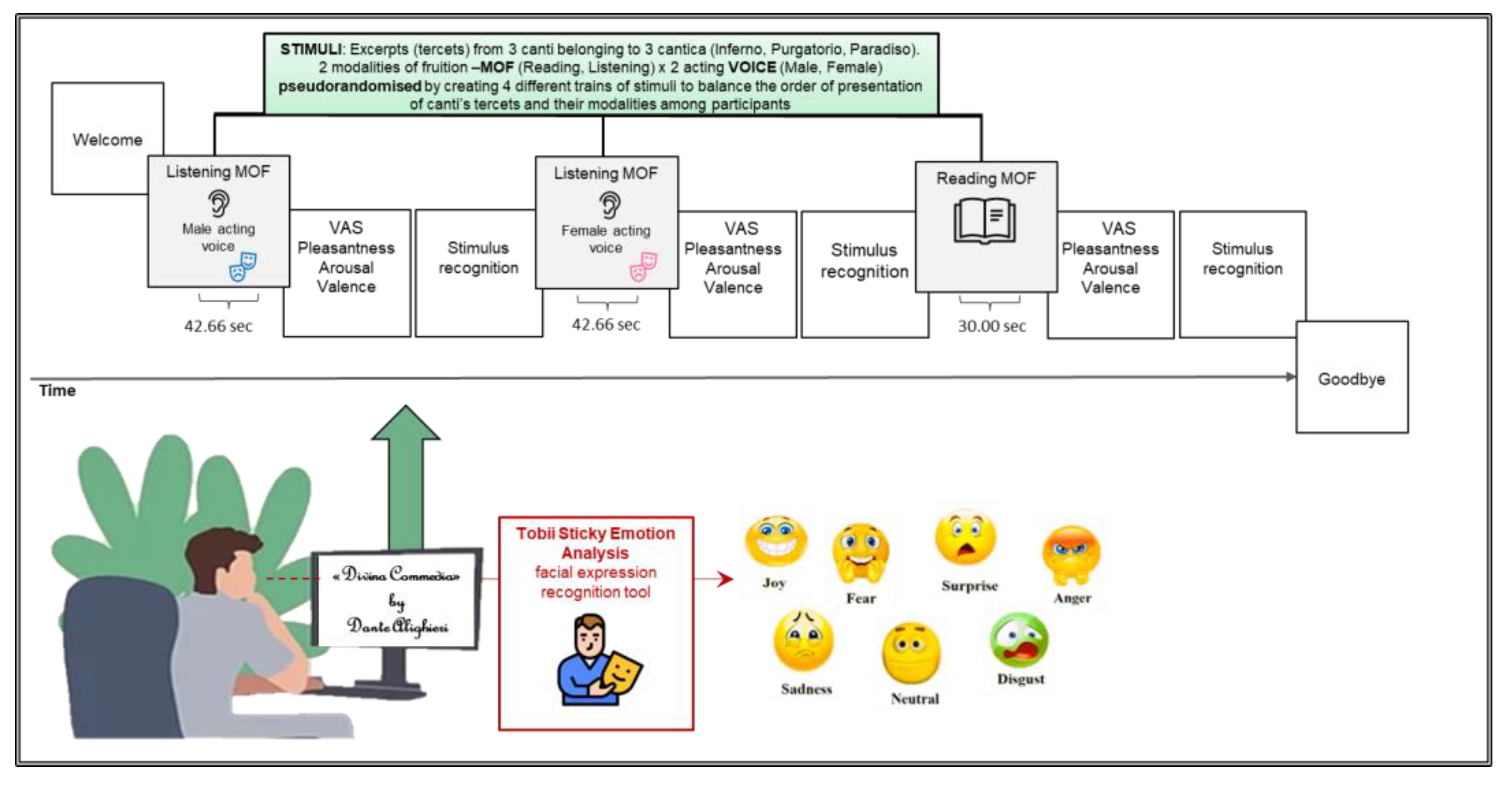
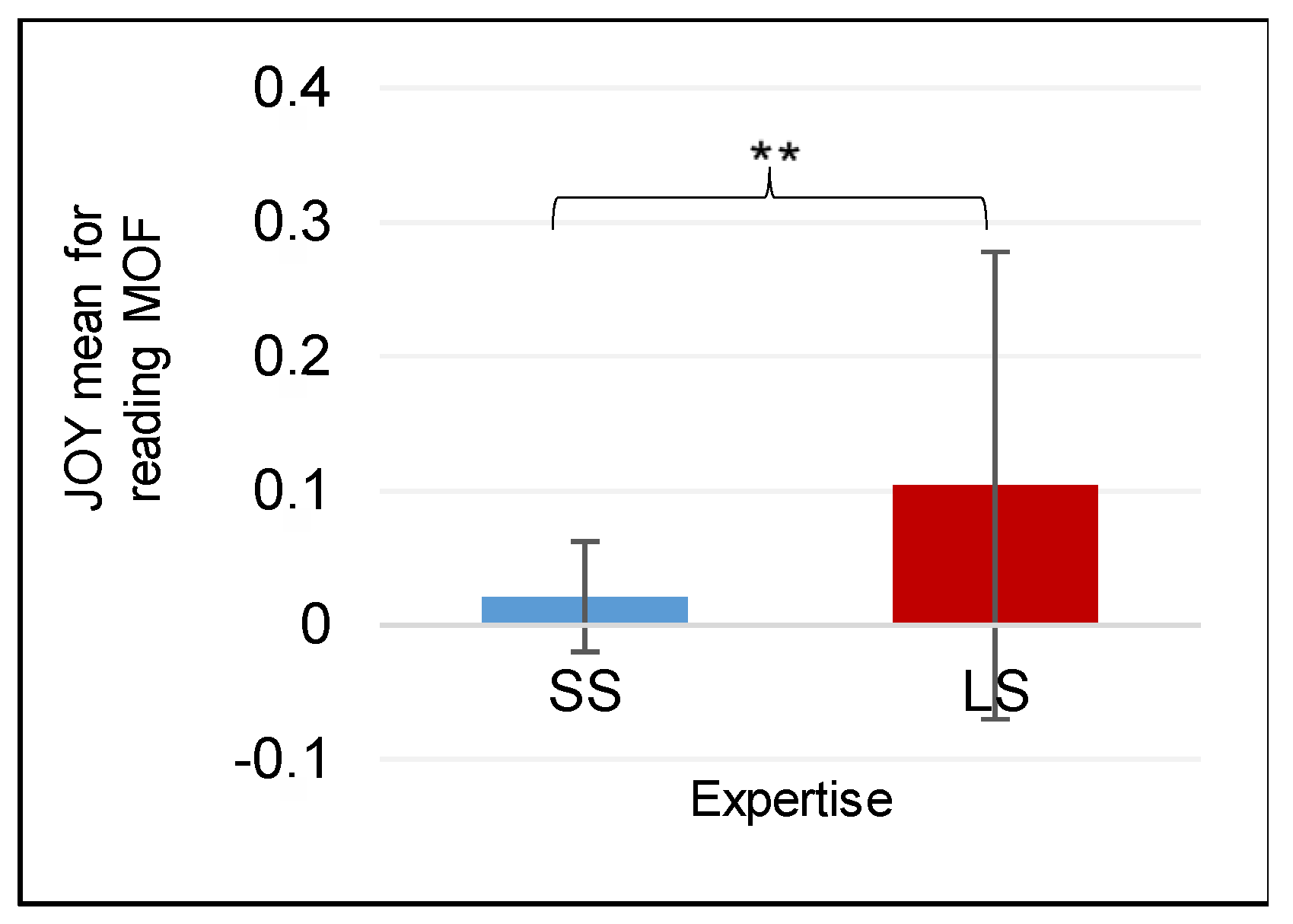
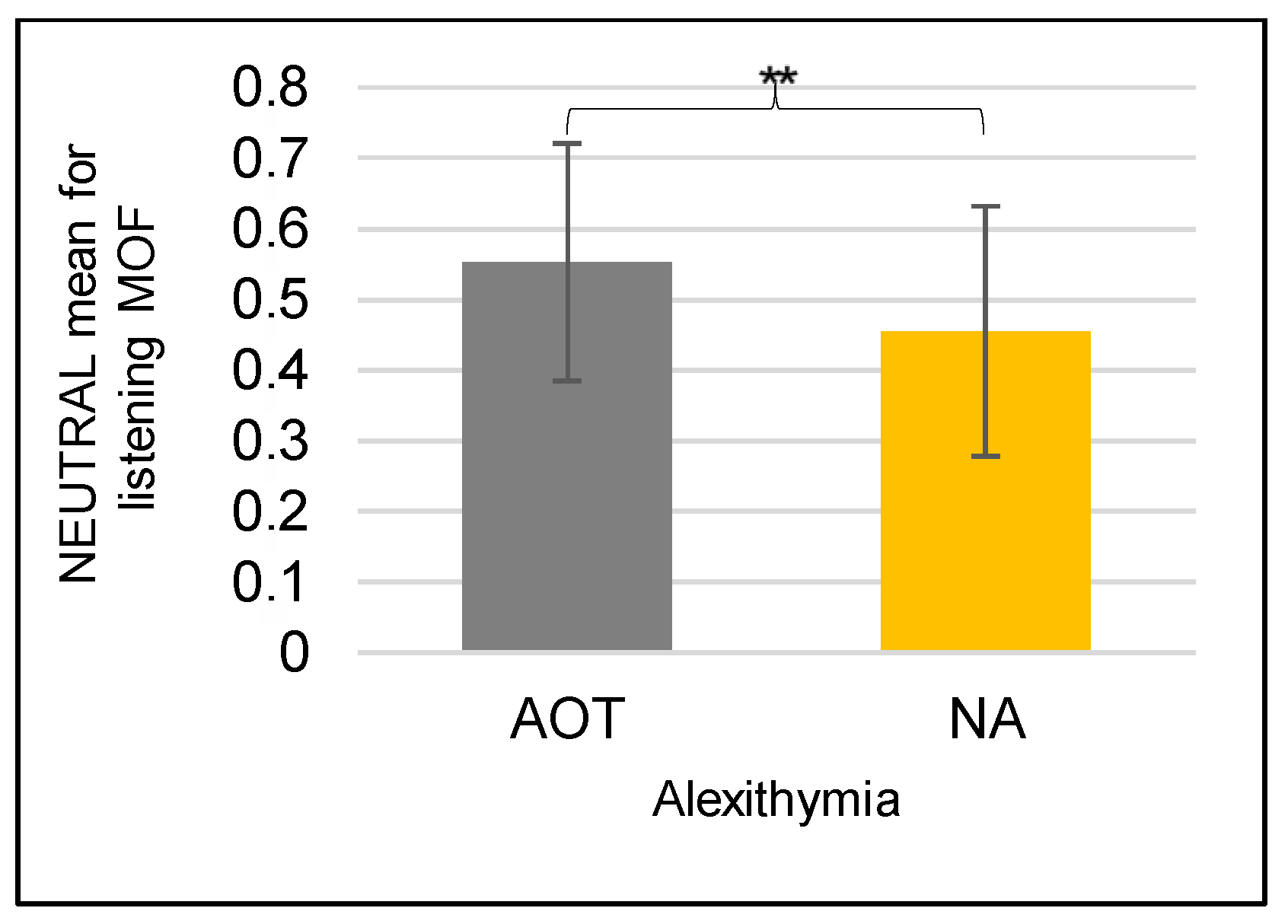
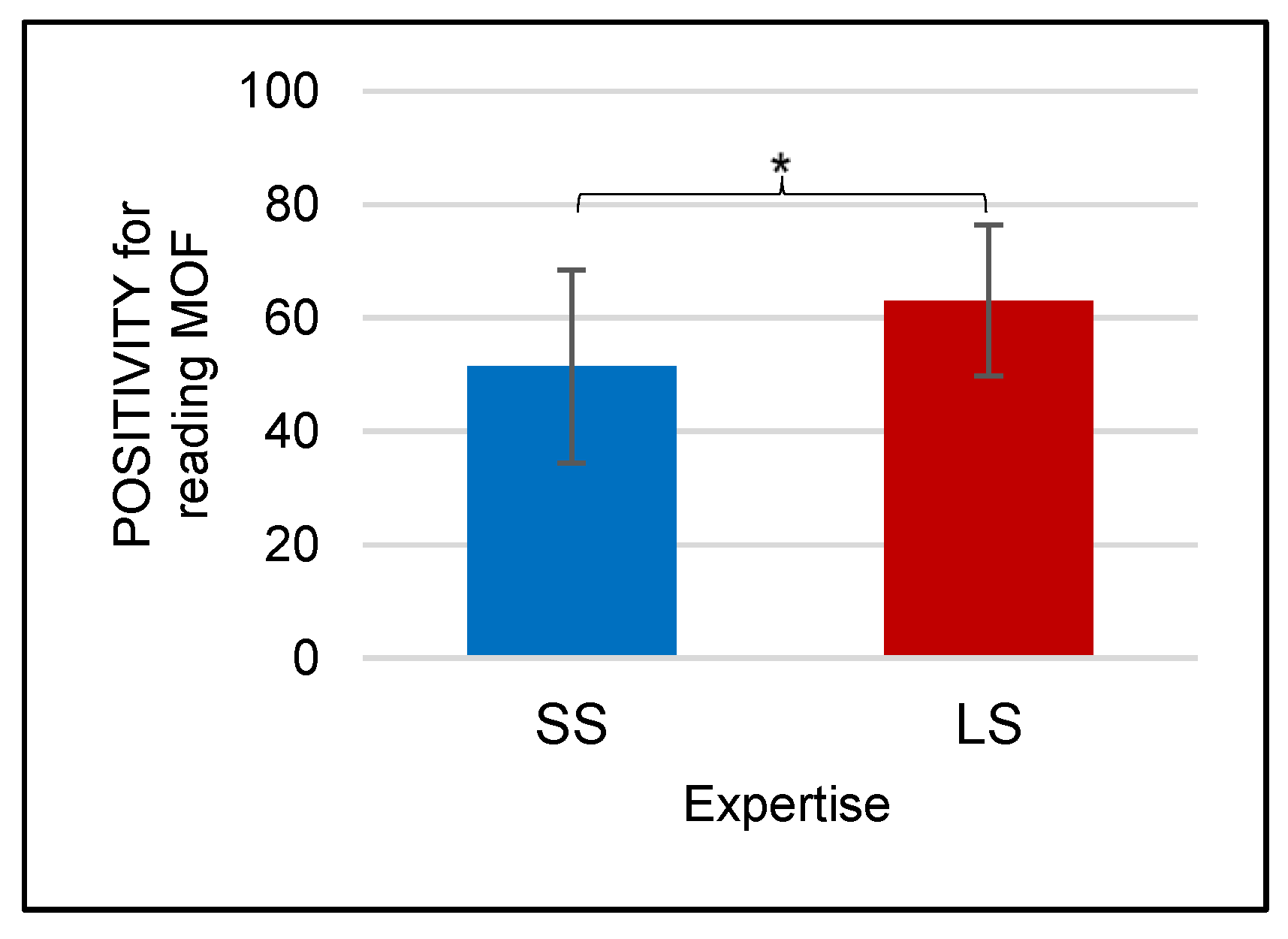
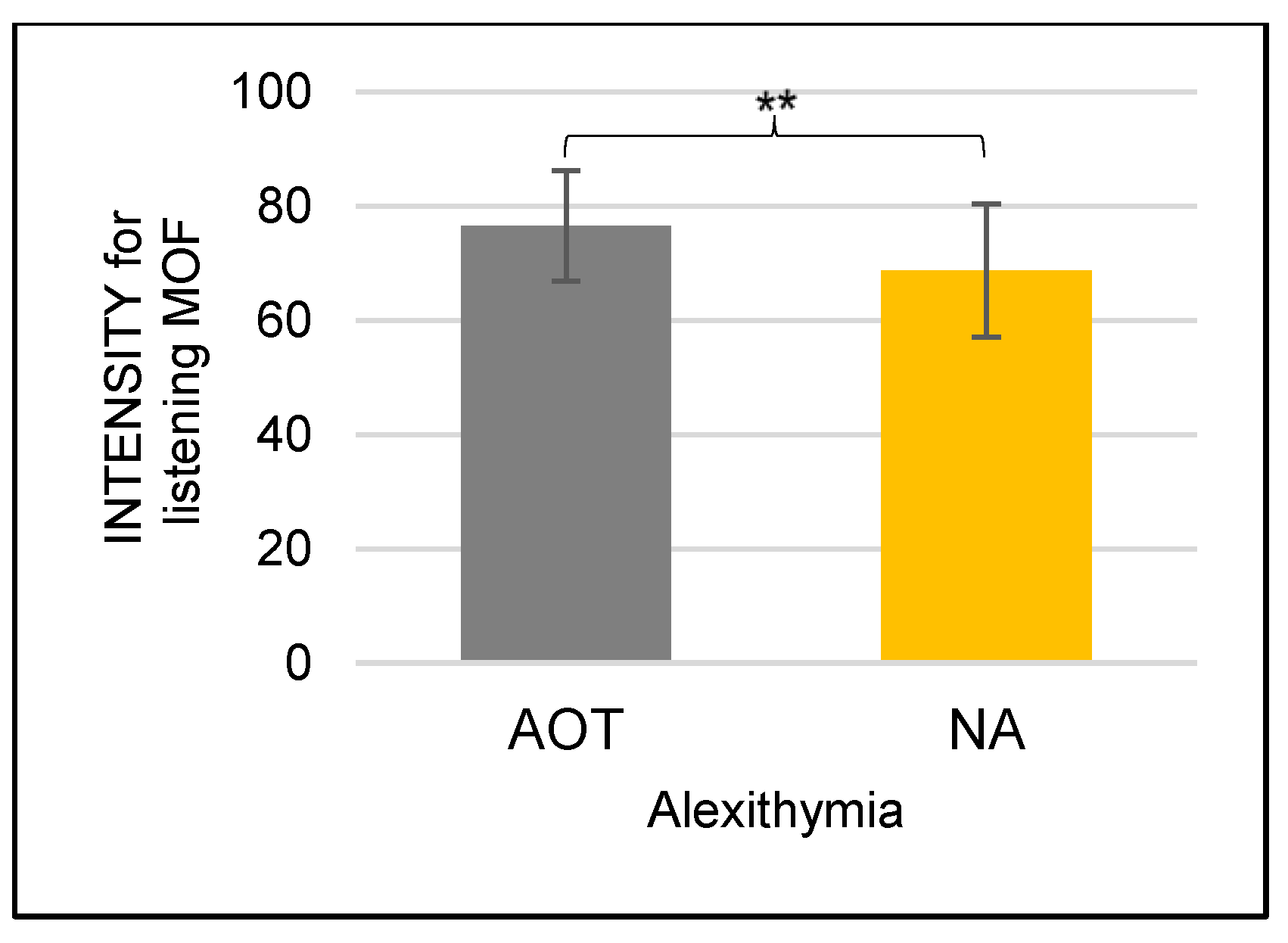
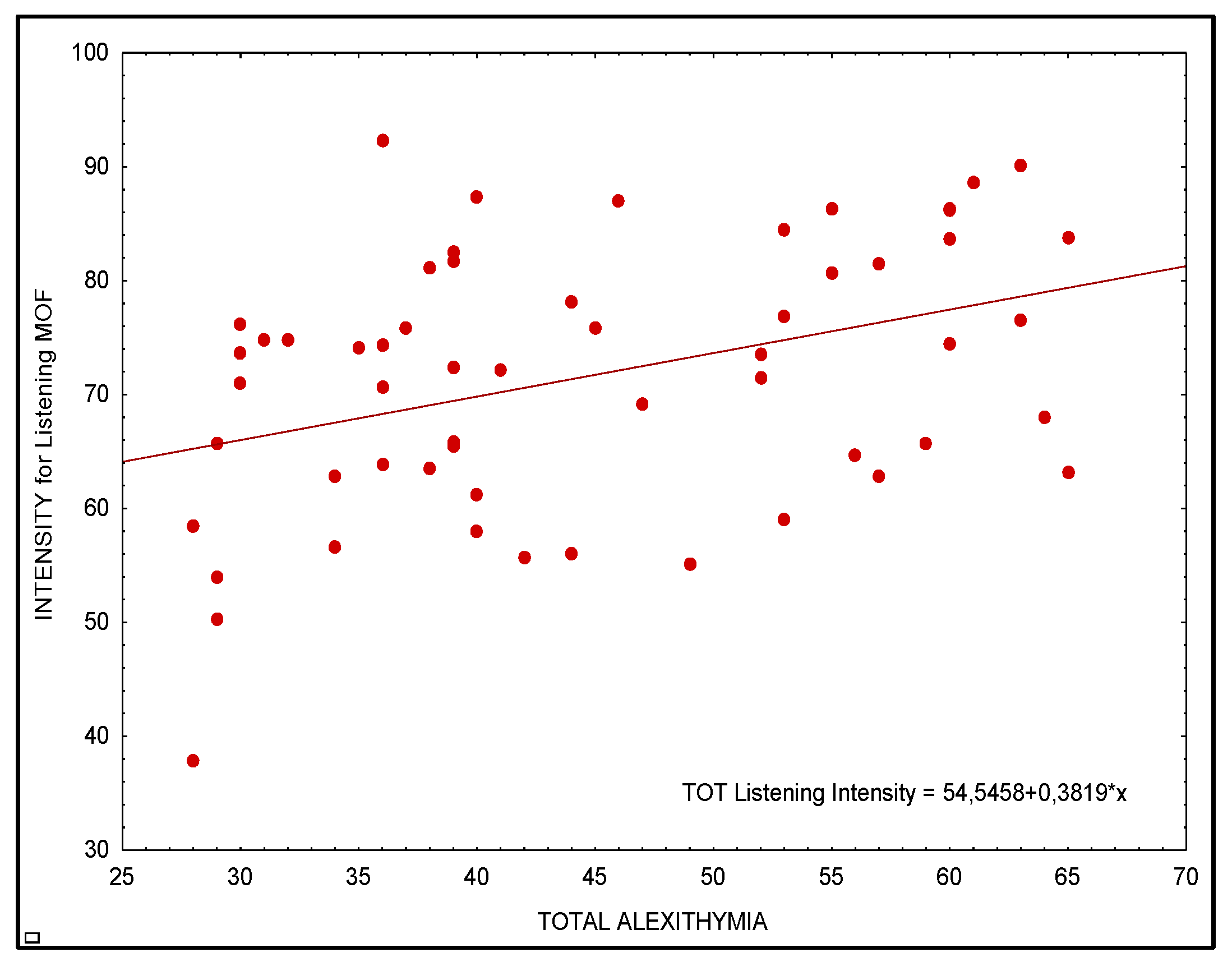
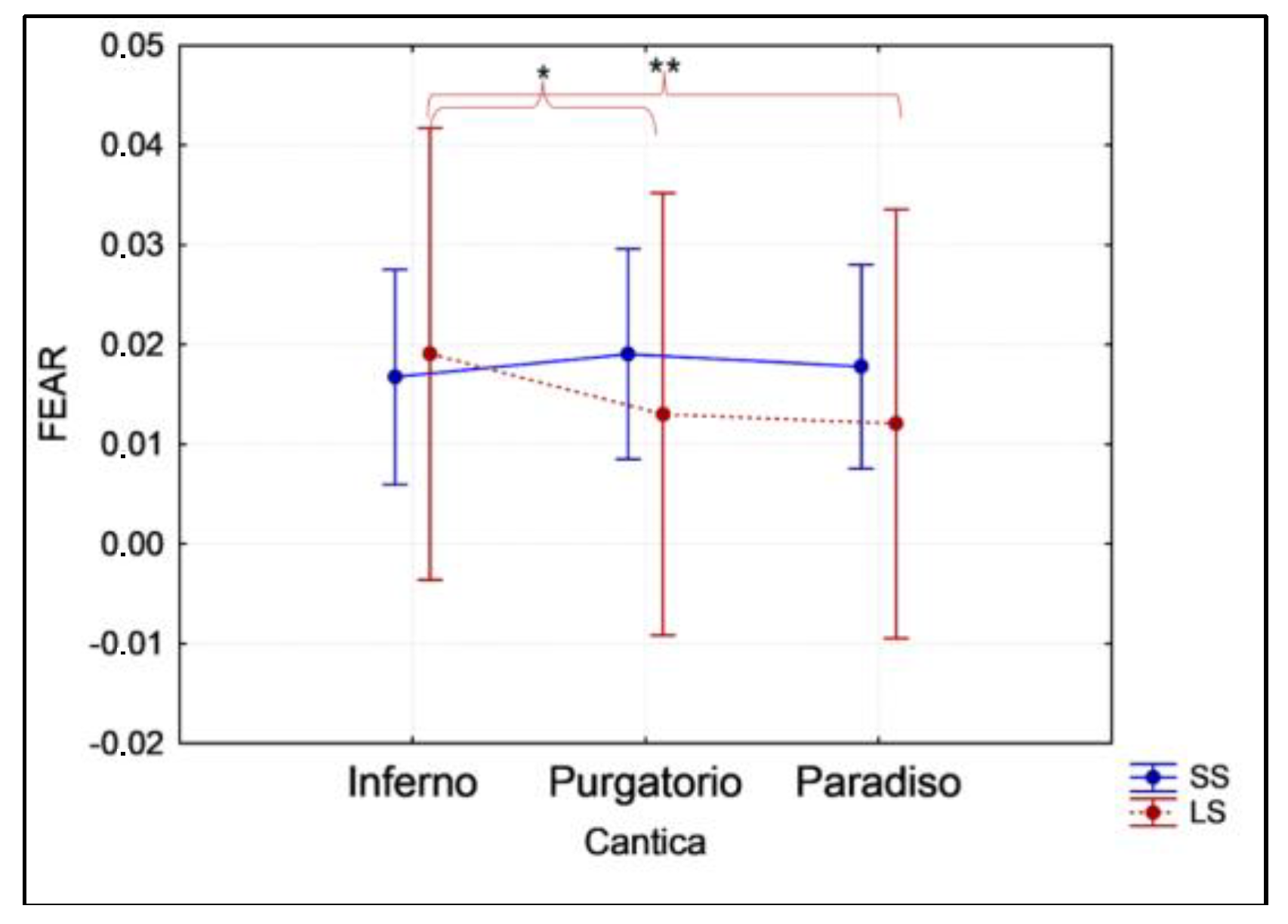
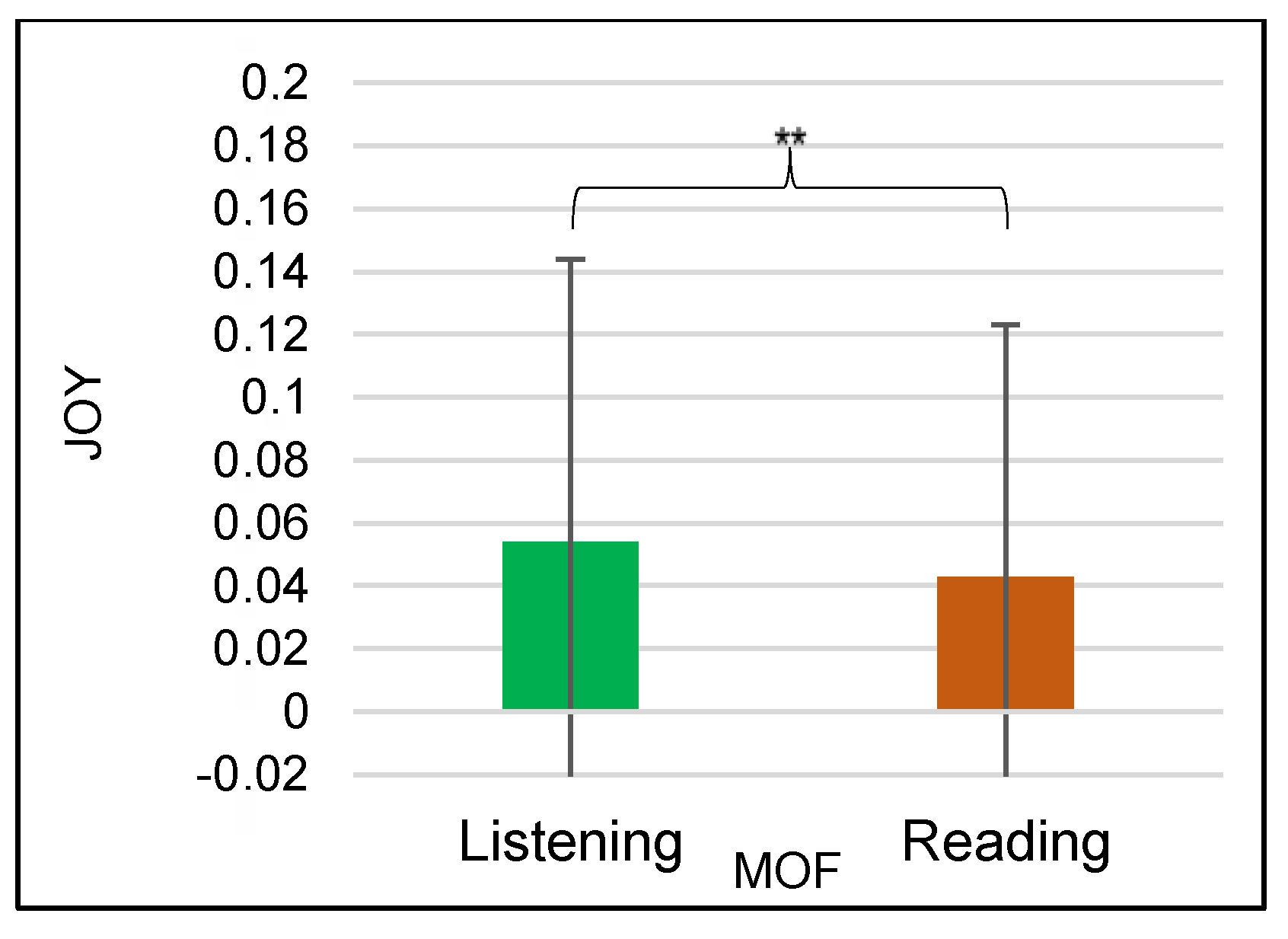
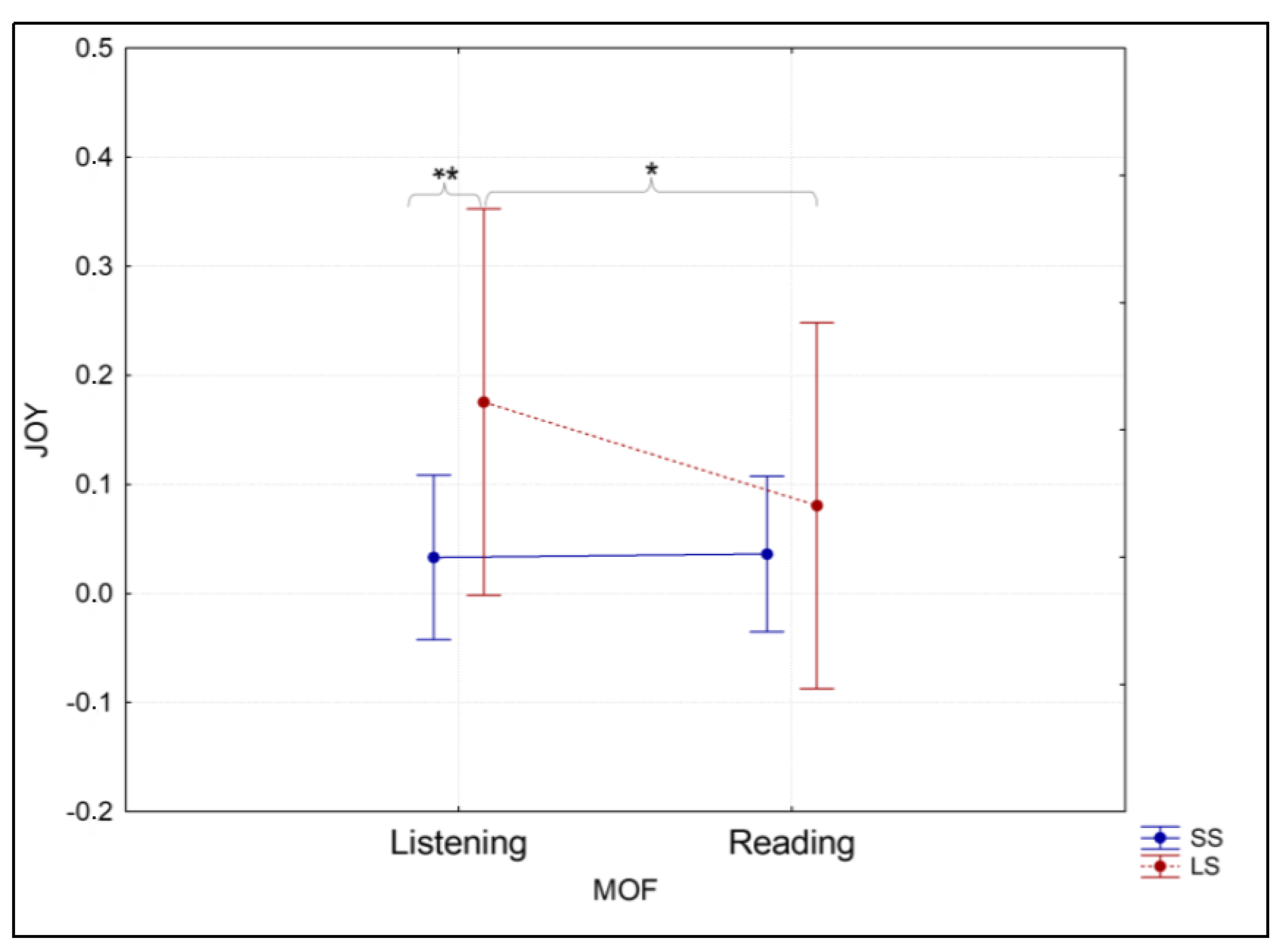
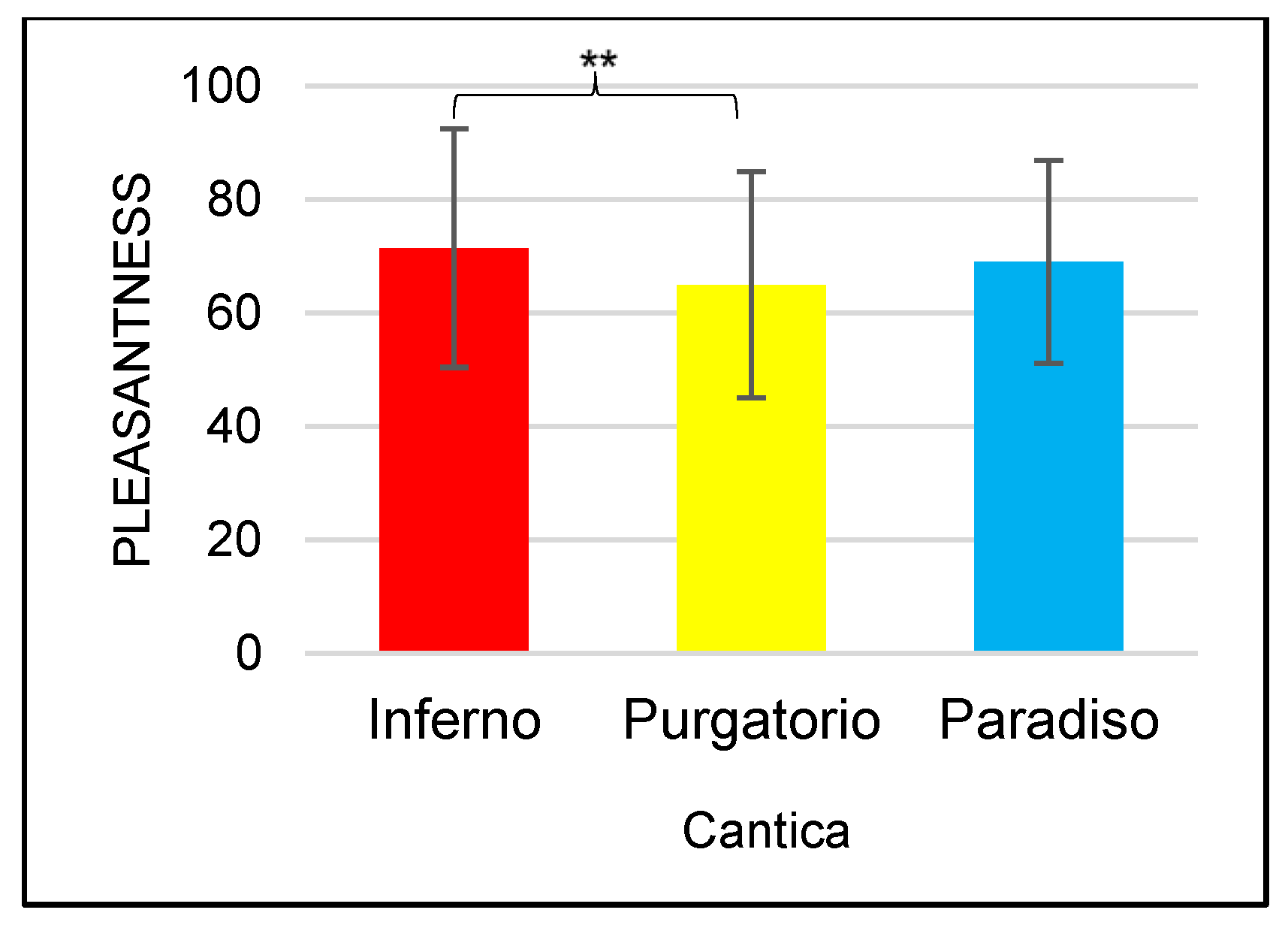
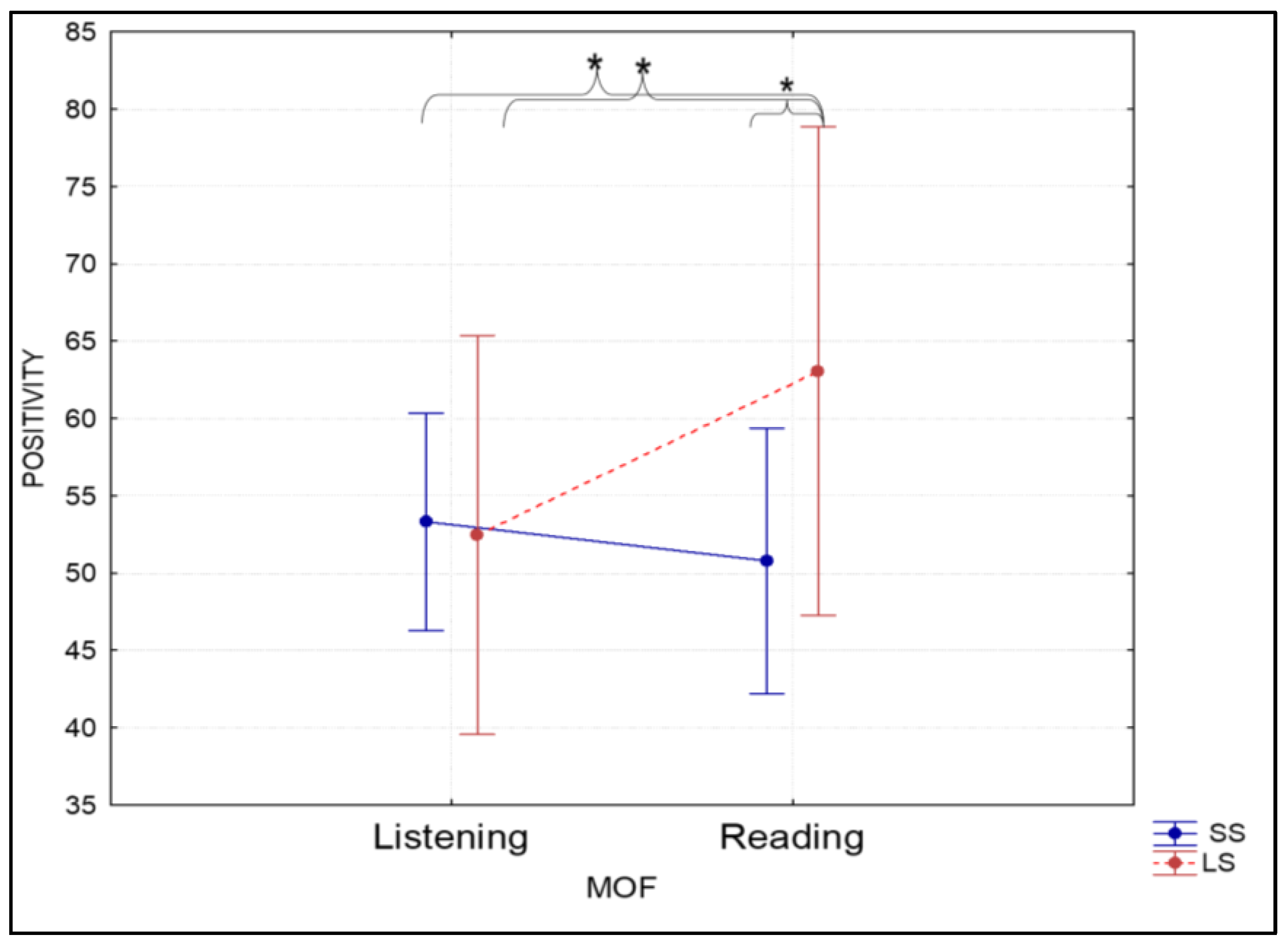
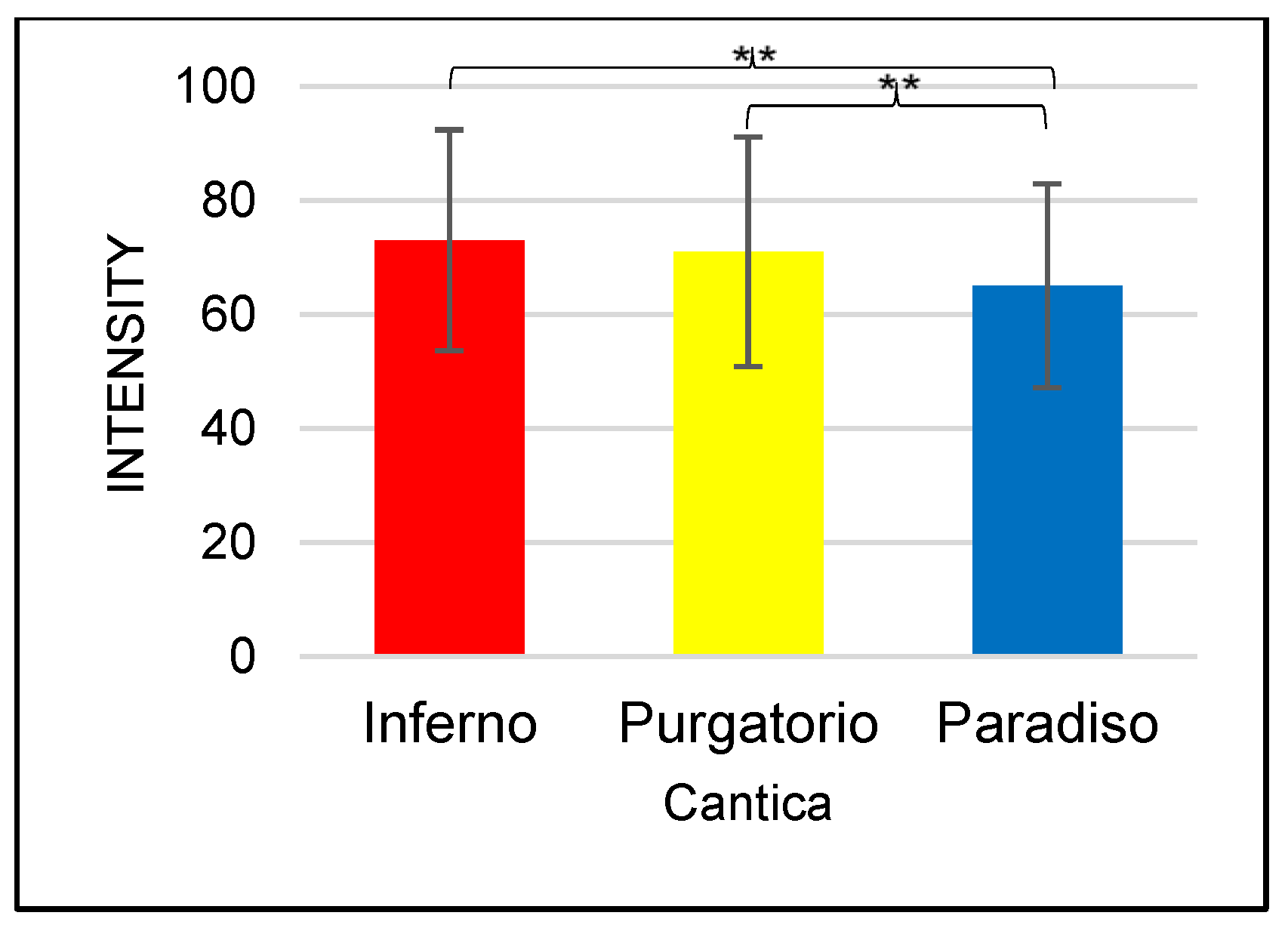
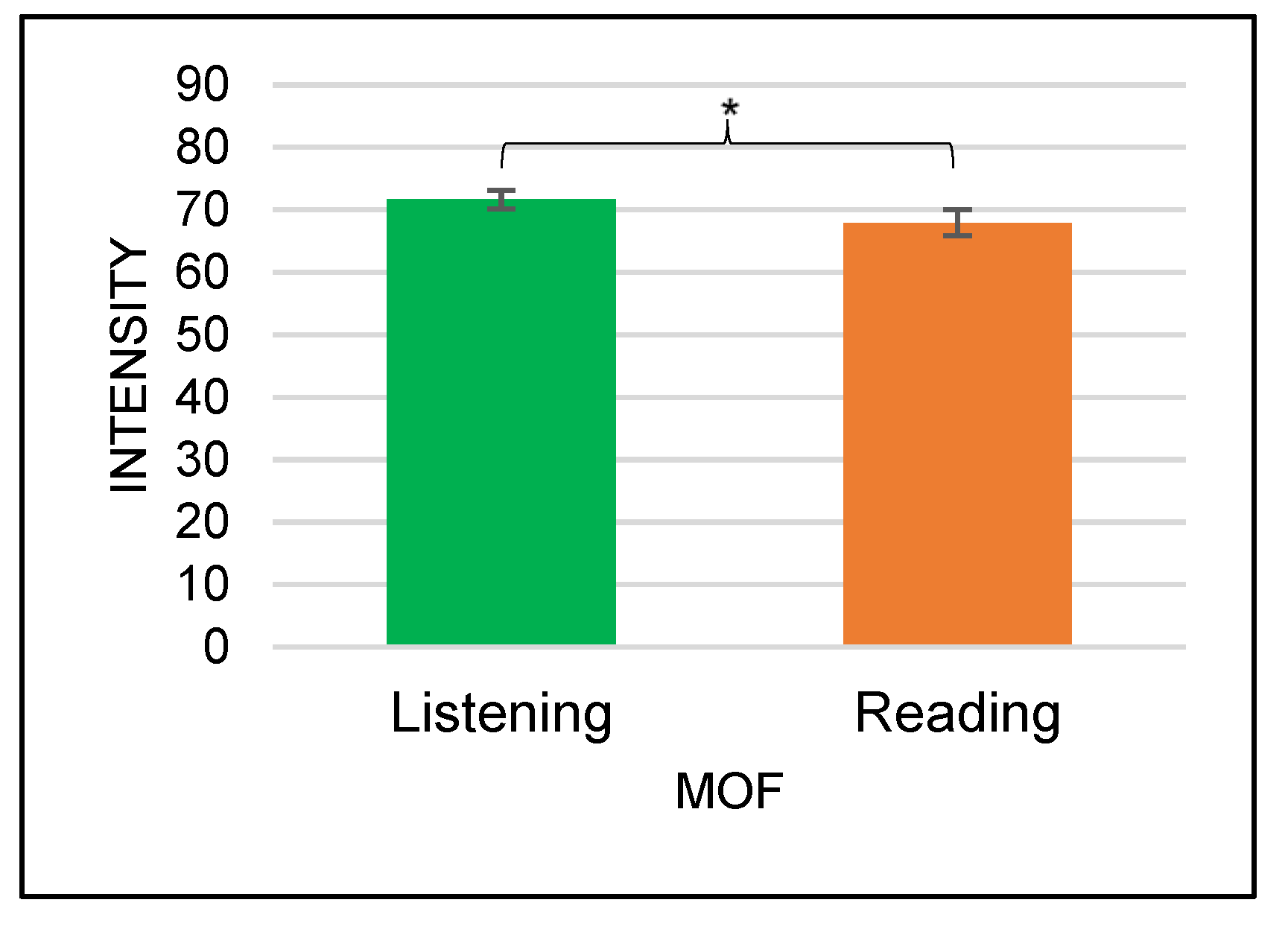
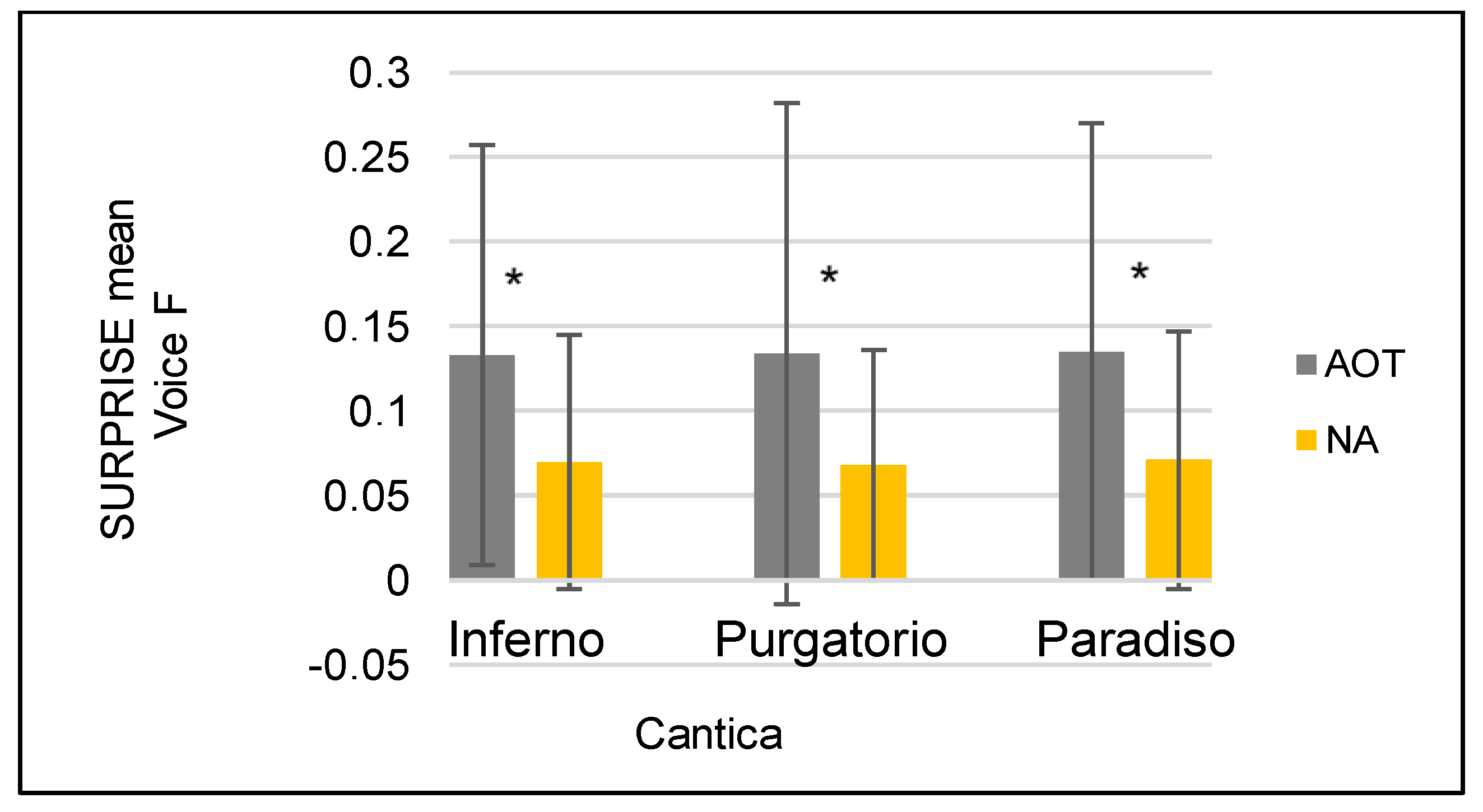
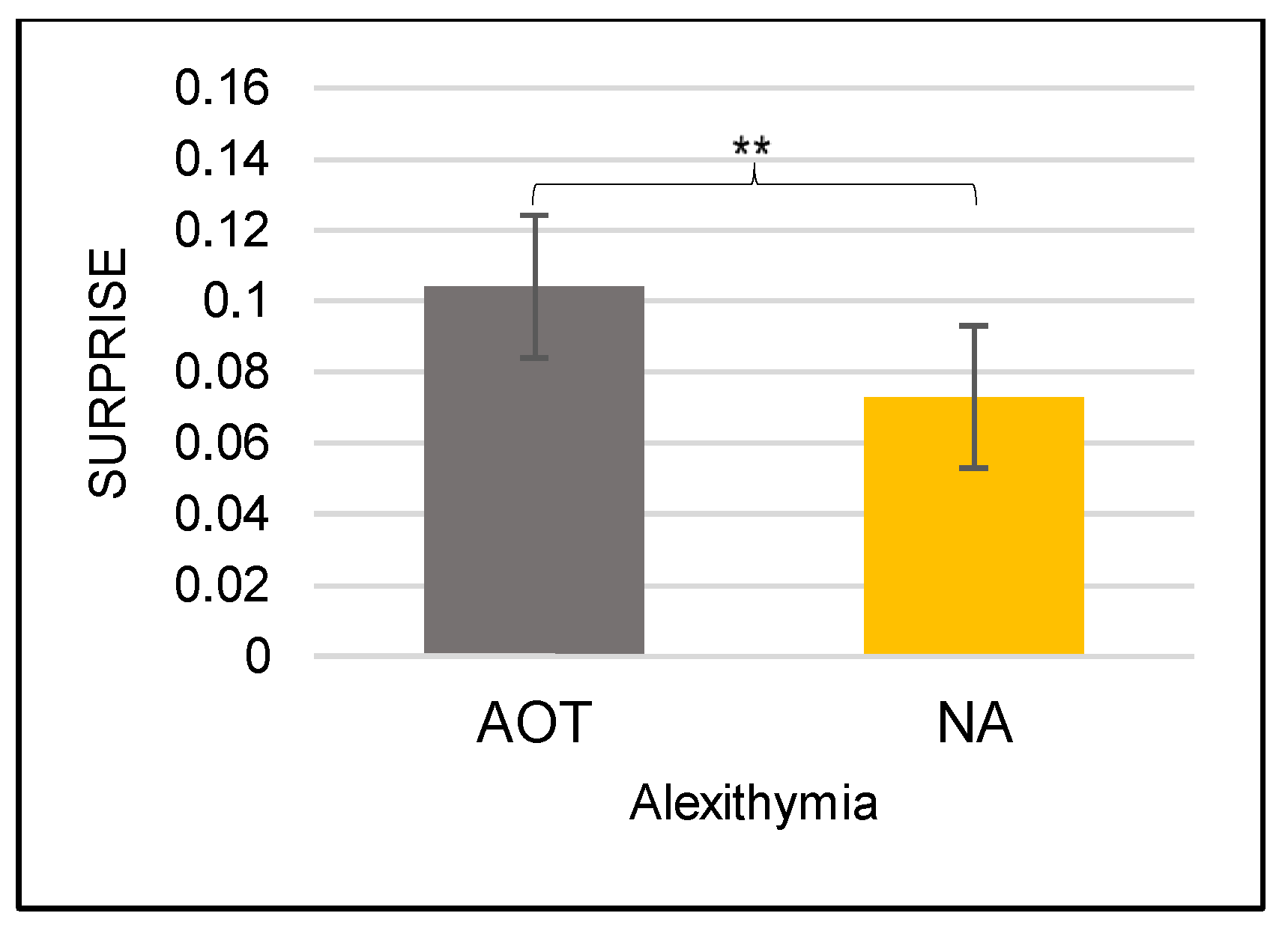
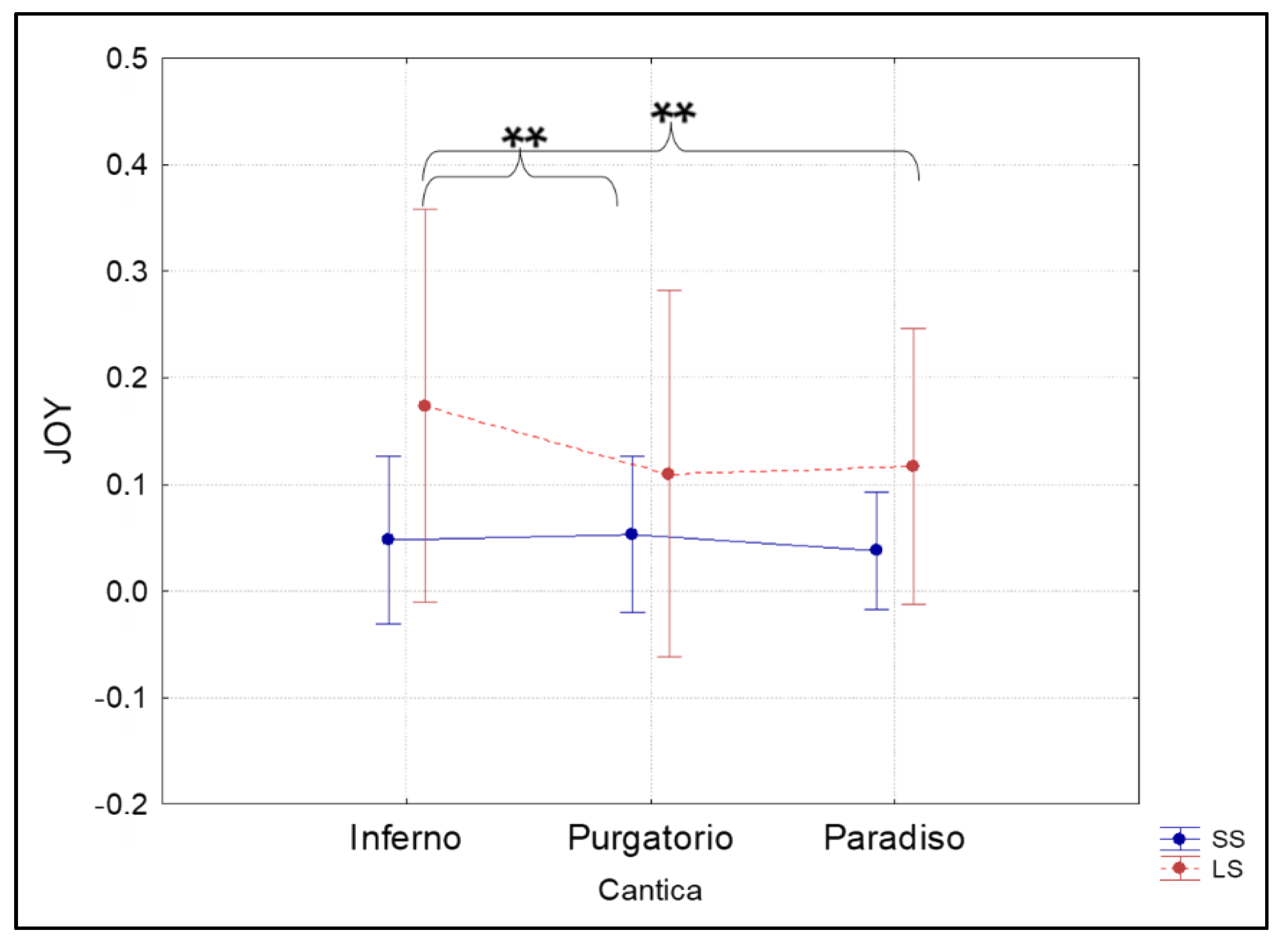
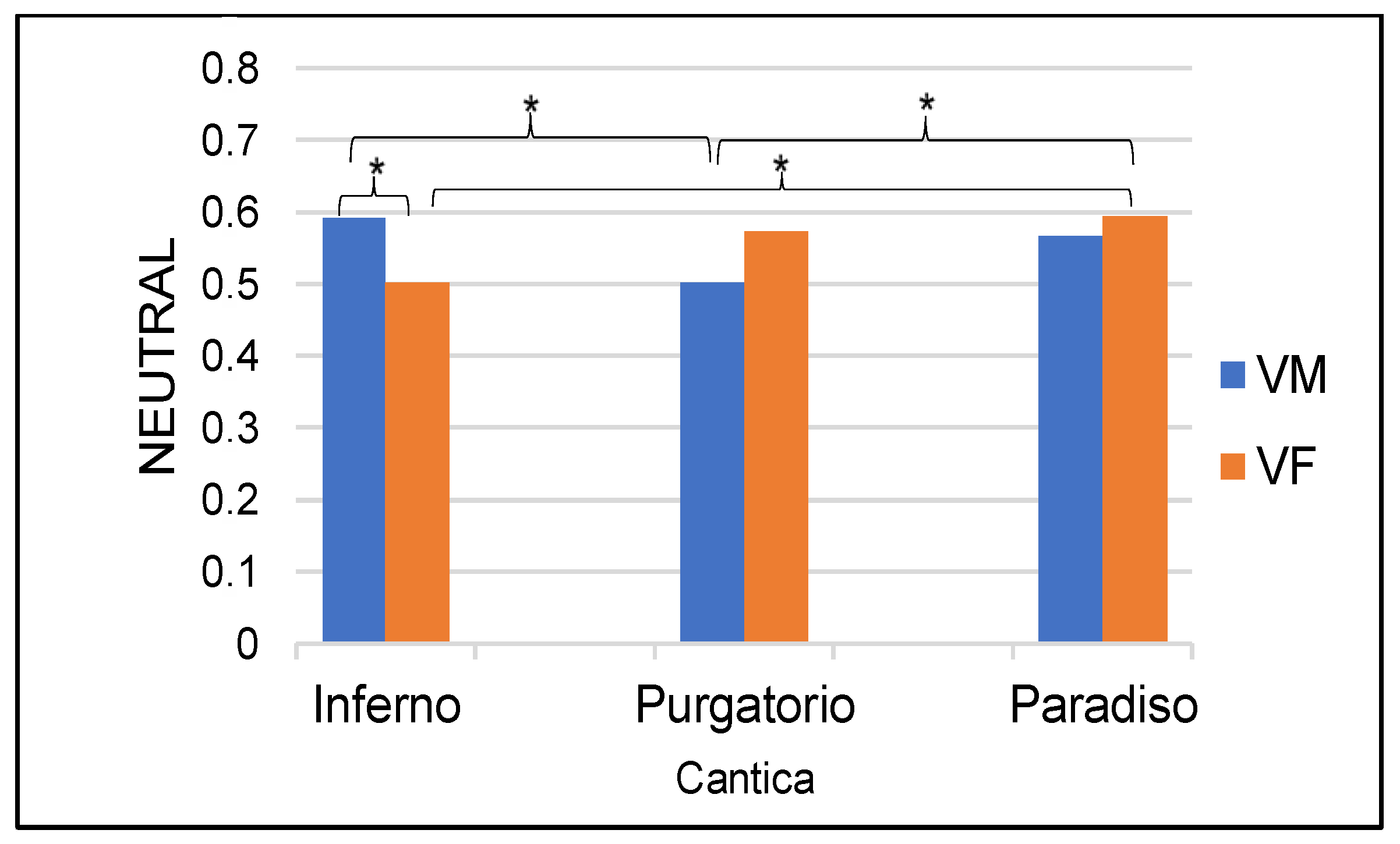
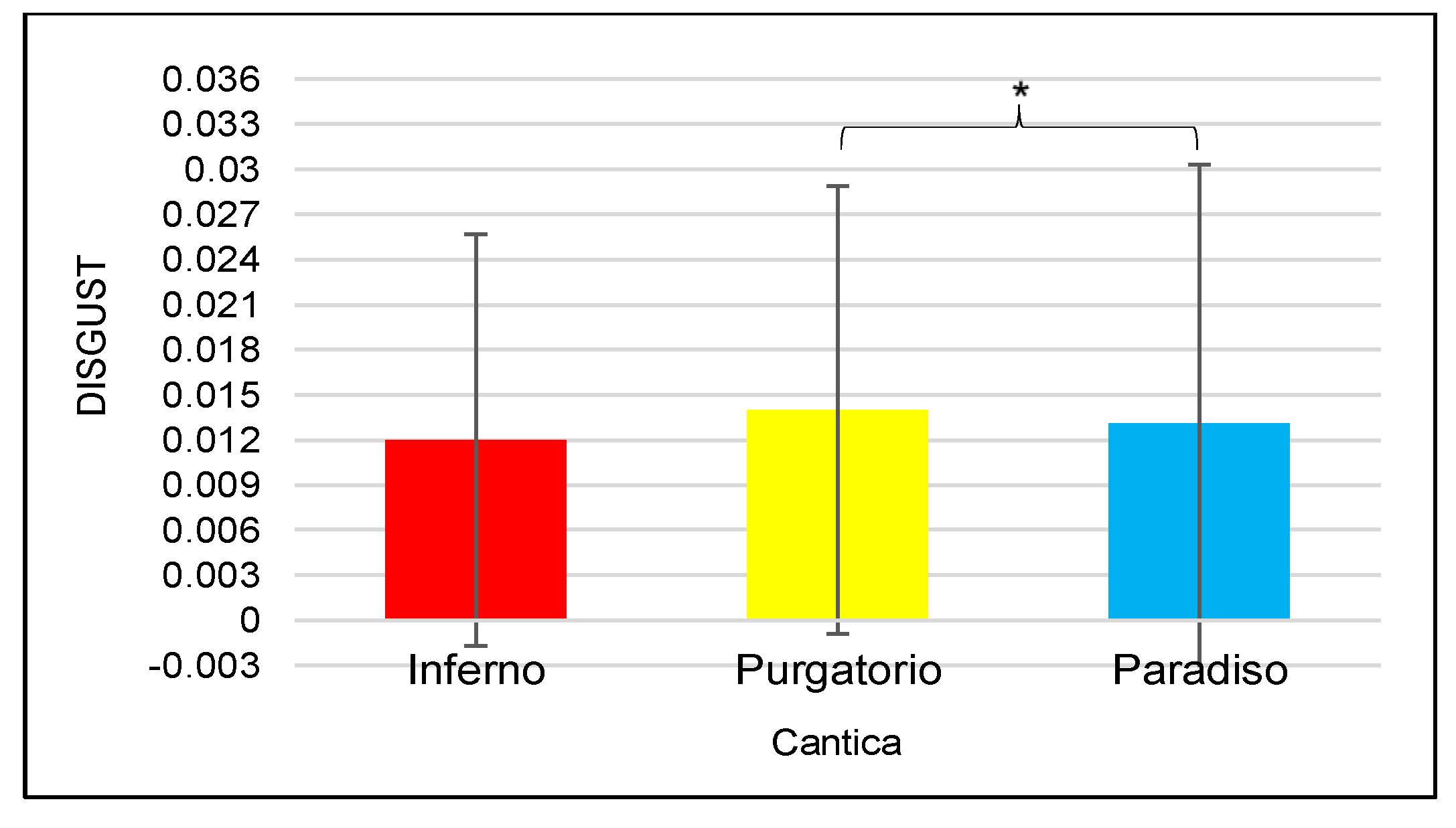
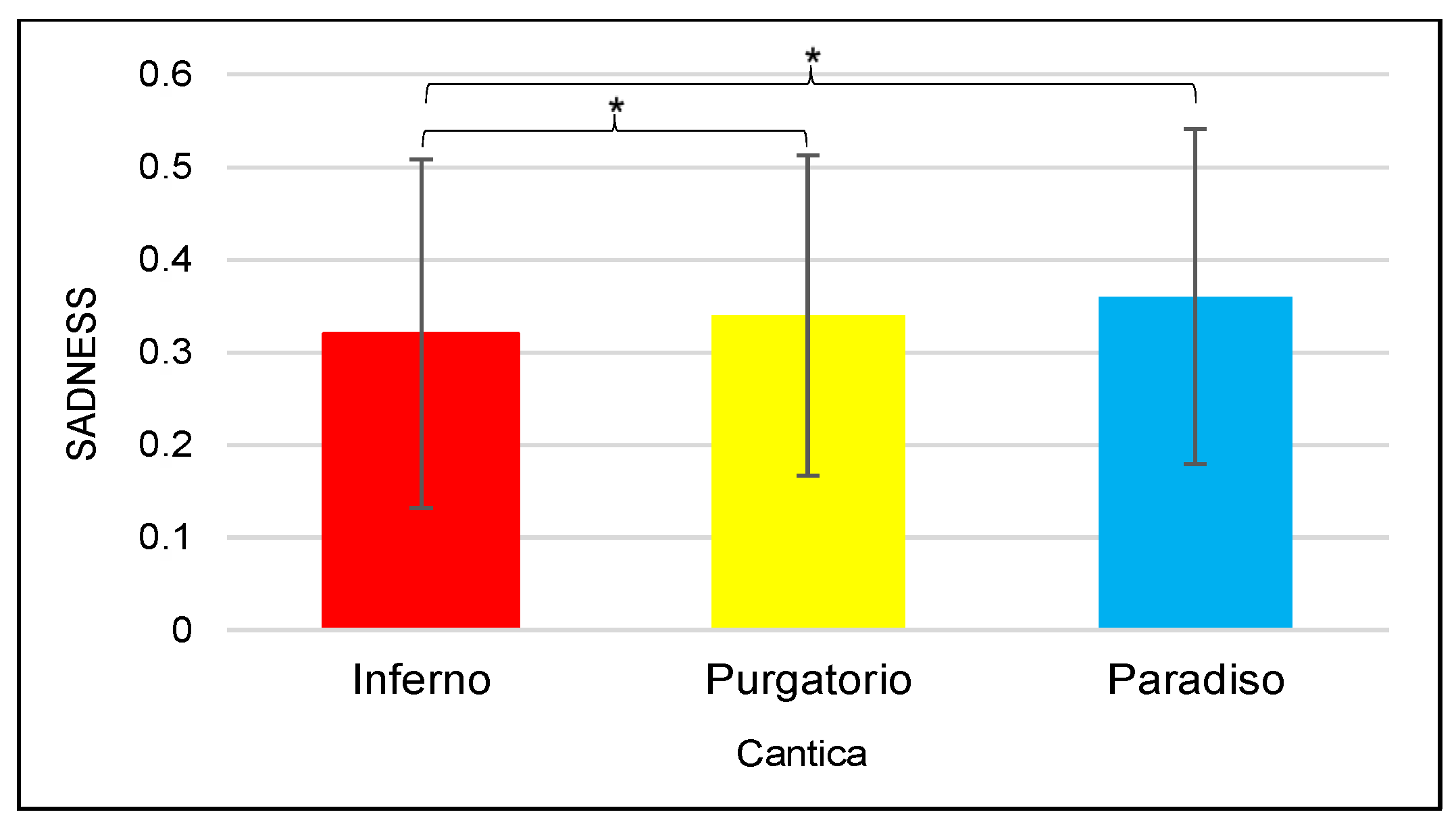
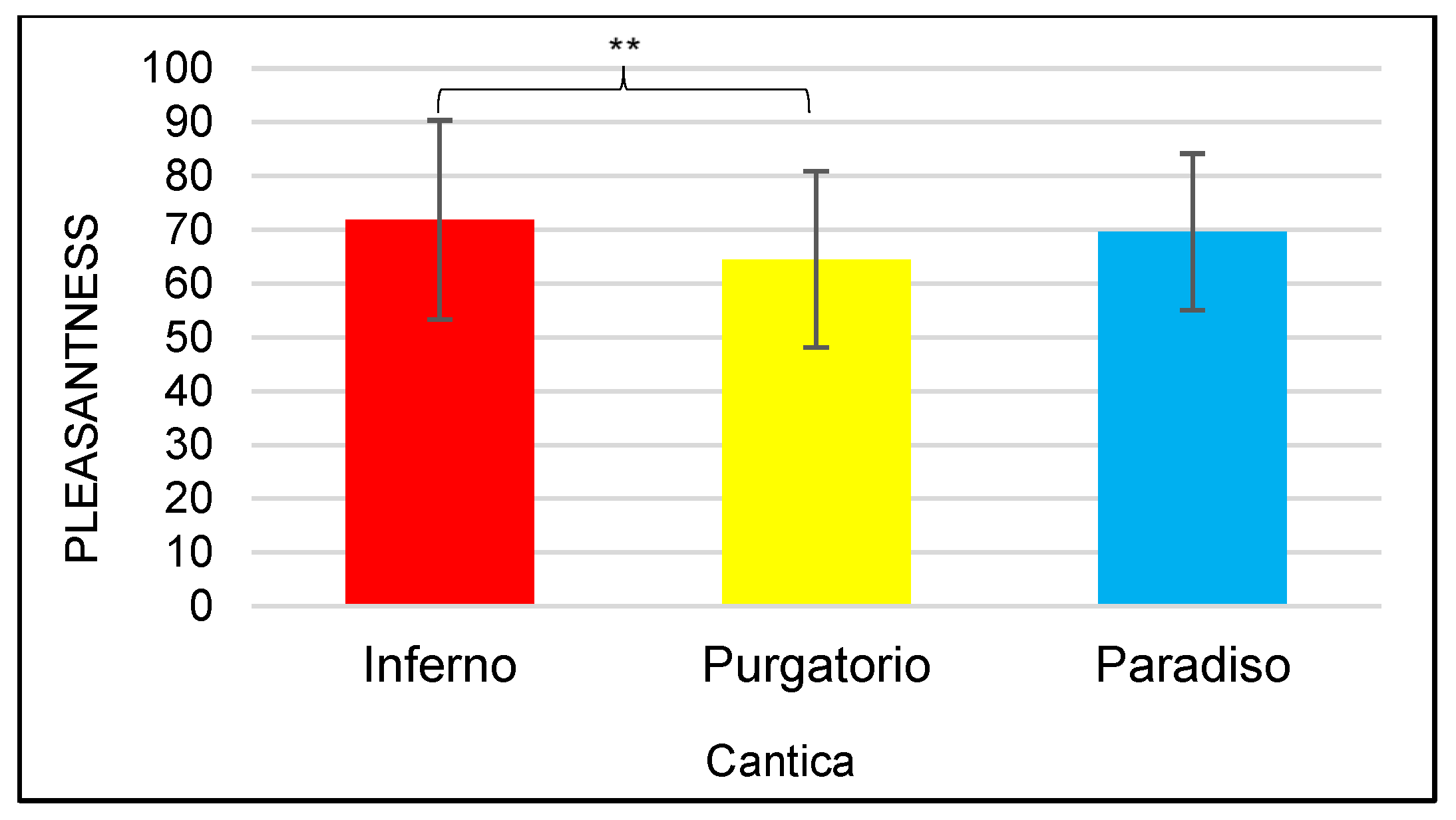
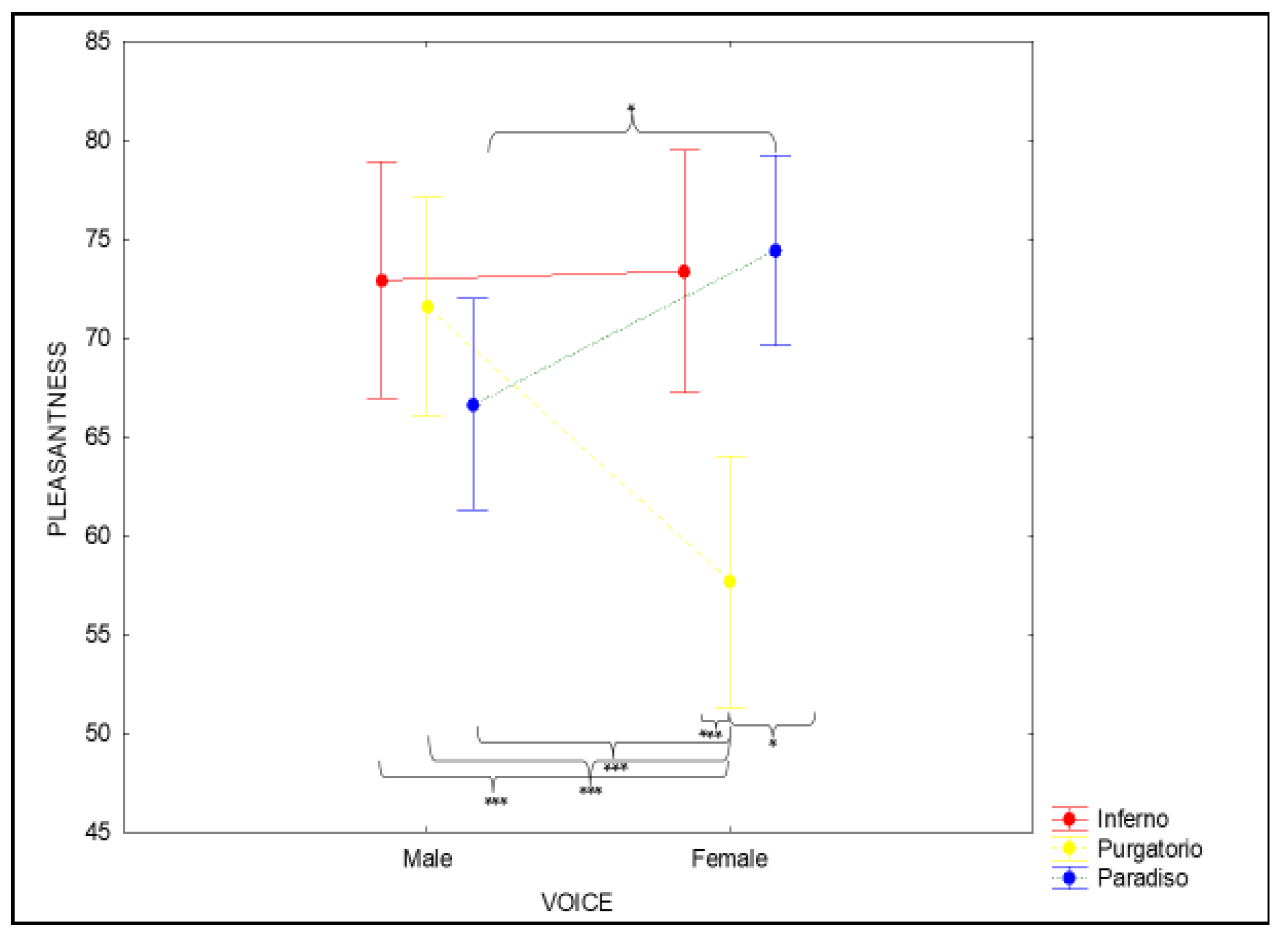
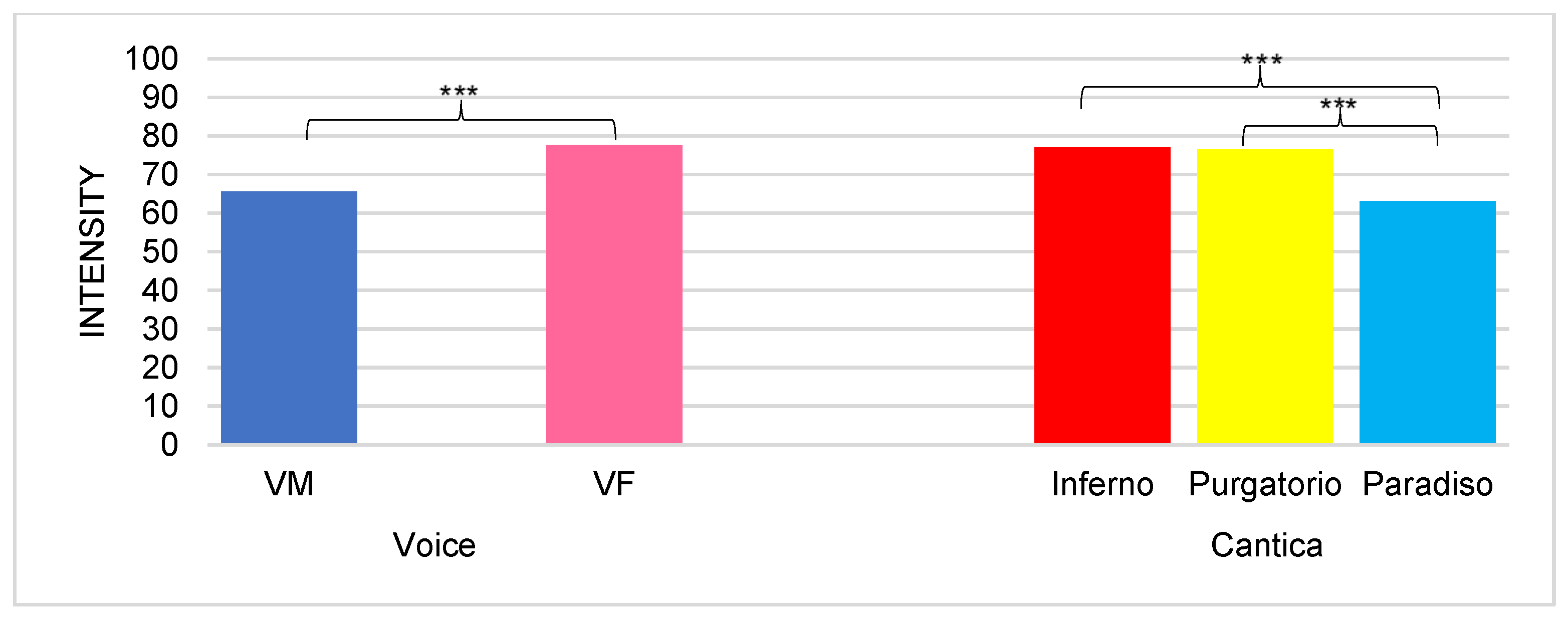
Disclaimer/Publisher’s Note: The statements, opinions and data contained in all publications are solely those of the individual author(s) and contributor(s) and not of MDPI and/or the editor(s). MDPI and/or the editor(s) disclaim responsibility for any injury to people or property resulting from any ideas, methods, instructions or products referred to in the content. |
© 2023 by the authors. Licensee MDPI, Basel, Switzerland. This article is an open access article distributed under the terms and conditions of the Creative Commons Attribution (CC BY) license (https://creativecommons.org/licenses/by/4.0/).
Share and Cite
Inguscio, B.M.S.; Cartocci, G.; Palmieri, S.; Menicocci, S.; Vozzi, A.; Giorgi, A.; Ferrara, S.; Canettieri, P.; Babiloni, F. Poetry in Pandemic: A Multimodal Neuroaesthetic Study on the Emotional Reaction to the Divina Commedia Poem. Appl. Sci. 2023, 13, 3720. https://doi.org/10.3390/app13063720
Inguscio BMS, Cartocci G, Palmieri S, Menicocci S, Vozzi A, Giorgi A, Ferrara S, Canettieri P, Babiloni F. Poetry in Pandemic: A Multimodal Neuroaesthetic Study on the Emotional Reaction to the Divina Commedia Poem. Applied Sciences. 2023; 13(6):3720. https://doi.org/10.3390/app13063720
Chicago/Turabian StyleInguscio, Bianca Maria Serena, Giulia Cartocci, Simone Palmieri, Stefano Menicocci, Alessia Vozzi, Andrea Giorgi, Silvia Ferrara, Paolo Canettieri, and Fabio Babiloni. 2023. "Poetry in Pandemic: A Multimodal Neuroaesthetic Study on the Emotional Reaction to the Divina Commedia Poem" Applied Sciences 13, no. 6: 3720. https://doi.org/10.3390/app13063720
APA StyleInguscio, B. M. S., Cartocci, G., Palmieri, S., Menicocci, S., Vozzi, A., Giorgi, A., Ferrara, S., Canettieri, P., & Babiloni, F. (2023). Poetry in Pandemic: A Multimodal Neuroaesthetic Study on the Emotional Reaction to the Divina Commedia Poem. Applied Sciences, 13(6), 3720. https://doi.org/10.3390/app13063720








